
251+ Life Science Research Topics [Updated]
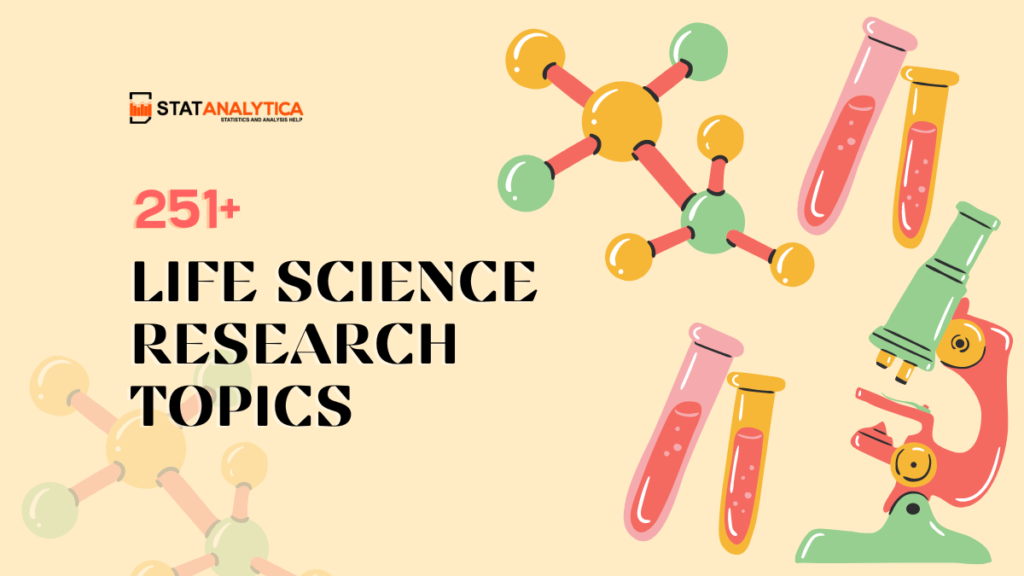
Life science research is like peering into the intricate workings of the universe, but instead of stars and galaxies, it delves into the mysteries of life itself. From unraveling the secrets of our genetic code to understanding ecosystems and everything in between, life science research encompasses a vast array of fascinating topics. In this blog post, we’ll embark on a journey through some of the most captivating life science research topics within the realm of life science research.
What is research in life science?
Table of Contents
Research in life science involves the systematic investigation and study of living organisms, their interactions, and their environments. It encompasses a wide range of disciplines, including biology, genetics, ecology, microbiology, neuroscience, and more.
Life science research aims to expand our understanding of the fundamental principles governing life processes, uncover new insights into biological systems, develop innovative technologies and therapies, and address pressing challenges in areas such as healthcare, agriculture, and conservation.
251+ Life Science Research Topics: Category Wise
Genetics and genomics.
- Genetic basis of inherited diseases
- Genome-wide association studies
- Epigenetics and gene regulation
- Evolutionary genomics
- CRISPR/Cas9 gene editing technology
- Pharmacogenomics and personalized medicine
- Population genetics
- Functional genomics
- Comparative genomics across species
- Genetic diversity and conservation
Biotechnology and Bioengineering
- Biopharmaceutical production
- Metabolic engineering for biofuel production
- Synthetic biology applications
- Bioremediation techniques
- Nanotechnology in drug delivery
- Tissue engineering and regenerative medicine
- Biosensors for environmental monitoring
- Bioprocessing optimization
- Biodegradable plastics and sustainable materials
- Agricultural biotechnology for crop improvement
Ecology and Environmental Biology
- Biodiversity hotspots and conservation strategies
- Ecosystem services and human well-being
- Climate change impacts on ecosystems
- Restoration ecology techniques
- Urban ecology and biodiversity
- Marine biology and coral reef conservation
- Habitat fragmentation and species extinction
- Ecological modeling and forecasting
- Wildlife conservation genetics
- Microbial ecology in natural environments
Neuroscience and Cognitive Science
- Brain mapping techniques (fMRI, EEG, etc.)
- Neuroplasticity and learning
- Neural circuitry underlying behavior
- Neurodegenerative diseases (Alzheimer’s, Parkinson’s, etc.)
- Neural engineering for prosthetics
- Consciousness and the mind-body problem
- Psychiatric genetics and mental health disorders
- Neuroimaging in psychiatric research
- Developmental cognitive neuroscience
- Neural correlates of consciousness
Evolutionary Biology
- Mechanisms of speciation
- Molecular evolution and phylogenetics
- Coevolutionary dynamics
- Evolution of antibiotic resistance
- Cultural evolution and human behavior
- Evolutionary consequences of climate change
- Evolutionary game theory
- Evolutionary medicine and infectious diseases
- Evolutionary psychology and human cognition
- Paleogenomics and ancient DNA analysis
Cell Biology and Physiology
- Cell cycle regulation and cancer biology
- Stem cell biology and regenerative medicine
- Organelle dynamics and intracellular transport
- Cellular senescence and aging
- Ion channels and neuronal excitability
- Metabolic pathways and cellular energetics
- Cell signaling pathways in development and disease
- Autophagy and cellular homeostasis
- Mitochondrial function and disease
- Cell adhesion and migration in development and cancer
Microbiology and Immunology
- Microbiome composition and function
- Antibiotic resistance mechanisms
- Host-microbe interactions in health and disease
- Viral pathogenesis and vaccine development
- Microbial biotechnology for waste treatment
- Immunotherapy approaches for cancer treatment
- Microbial diversity in extreme environments
- Antimicrobial peptides and drug discovery
- Microbial biofilms and chronic infections
- Host immune responses to viral infections
Biomedical Research and Clinical Trials
- Translational research in oncology
- Precision medicine approaches
- Clinical trials for gene therapies
- Biomarker discovery for disease diagnosis
- Stem cell-based therapies for regenerative medicine
- Pharmacokinetics and drug metabolism studies
- Clinical trials for neurodegenerative diseases
- Vaccine efficacy trials
- Patient-reported outcomes in clinical research
- Health disparities and clinical trial participation
Emerging Technologies and Innovations
- Single-cell omics technologies
- 3D bioprinting for tissue engineering
- CRISPR-based diagnostics
- Artificial intelligence applications in life sciences
- Organs-on-chip for drug screening
- Wearable biosensors for health monitoring
- Nanomedicine for targeted drug delivery
- Optogenetics for neuronal manipulation
- Quantum biology and biological systems
- Augmented reality in medical education
Ethical, Legal, and Social Implications (ELSI) in Life Sciences
- Privacy concerns in genomic research
- Ethical considerations in gene editing technologies
- Access to healthcare and genetic testing
- Intellectual property rights in biotechnology
- Informed consent in clinical trials
- Animal welfare in research
- Equity in environmental decision-making
- Data sharing and reproducibility in science
- Dual-use research and biosecurity
- Cultural perspectives on biomedicine and genetics
Public Health and Epidemiology
- Disease surveillance and outbreak investigation
- Global health disparities and access to healthcare
- Environmental factors in disease transmission
- Health impacts of climate change
- Social determinants of health
- Infectious disease modeling and forecasting
- Vaccination strategies and herd immunity
- Epidemiology of chronic diseases
- Mental health epidemiology
- Occupational health and safety
Plant Biology and Agriculture
- Crop domestication and evolution
- Plant-microbe interactions in agriculture
- Genetic engineering for crop improvement
- Plant hormone signaling pathways
- Abiotic stress tolerance mechanisms in plants
- Soil microbiology and nutrient cycling
- Agroecology and sustainable farming practices
- Plant secondary metabolites and natural products
- Plant developmental biology
- Plant epigenetics and environmental adaptation
Bioinformatics and Computational Biology
- Genome assembly and annotation algorithms
- Phylogenetic tree reconstruction methods
- Metagenomic data analysis pipelines
- Machine learning approaches for biomarker discovery
- Structural bioinformatics and protein modeling
- Systems biology and network analysis
- Transcriptomic data analysis tools
- Population genetics simulation software
- Evolutionary algorithms in bioinformatics
- Cloud computing in life sciences research
Toxicology and Environmental Health
- Mechanisms of chemical toxicity
- Risk assessment methodologies
- Environmental fate and transport of pollutants
- Endocrine disruptors and reproductive health
- Nanotoxicology and nanomaterial safety
- Biomonitoring of environmental contaminants
- Ecotoxicology and wildlife health
- Air pollution exposure and respiratory health
- Water quality and aquatic ecosystems
- Environmental justice and health disparities
Aquatic Biology and Oceanography
- Marine biodiversity conservation strategies
- Ocean acidification impacts on marine life
- Coral reef resilience and restoration
- Fisheries management and sustainable harvesting
- Deep-sea biodiversity and exploration
- Harmful algal blooms and ecosystem health
- Marine mammal conservation efforts
- Microplastics pollution in aquatic environments
- Ocean circulation and climate regulation
- Aquaculture and mariculture technologies
Social and Behavioral Sciences in Health
- Health behavior change interventions
- Social determinants of health disparities
- Health communication strategies
- Community-based participatory research
- Patient-centered care approaches
- Cultural competence in healthcare delivery
- Health literacy interventions
- Stigma reduction efforts in public health
- Health policy analysis and advocacy
- Digital health technologies for behavior monitoring
Bioethics and Biomedical Ethics
- Ethical considerations in human subjects research
- Research ethics in vulnerable populations
- Privacy and data protection in healthcare
- Professional integrity and scientific misconduct
- Ethical implications of genetic testing
- Access to healthcare and health equity
- End-of-life care and euthanasia debates
- Reproductive ethics and assisted reproduction
- Ethical challenges in emerging biotechnologies
Forensic Science and Criminalistics
- DNA fingerprinting techniques
- Forensic entomology and time of death estimation
- Trace evidence analysis methods
- Digital forensics in criminal investigations
- Ballistics and firearm identification
- Forensic anthropology and human identification
- Bloodstain pattern analysis
- Arson investigation techniques
- Forensic toxicology and drug analysis
- Forensic psychology and criminal profiling
Nutrition and Dietary Science
- Nutritional epidemiology studies
- Diet and chronic disease risk
- Functional foods and nutraceuticals
- Macronutrient metabolism pathways
- Micronutrient deficiencies and supplementation
- Gut microbiota and metabolic health
- Dietary interventions for weight management
- Food safety and risk assessment
- Sustainable diets and environmental impact
- Cultural influences on dietary habits
Entomology and Insect Biology
- Insect behavior and communication
- Insecticide resistance mechanisms
- Pollinator decline and conservation efforts
- Medical entomology and vector-borne diseases
- Invasive species management strategies
- Insect biodiversity in urban environments
- Agricultural pest management techniques
- Insect physiology and biochemistry
- Social insects and eusociality
- Insect symbiosis and microbial interactions
Zoology and Animal Biology
- Animal behavior and cognition
- Conservation genetics of endangered species
- Reproductive biology and breeding programs
- Wildlife forensics and illegal wildlife trade
- Comparative anatomy and evolutionary biology
- Animal welfare and ethics in research
- Physiological adaptations to extreme environments
- Zoological taxonomy and species discovery
- Animal communication and signaling
- Human-wildlife conflict mitigation strategies
Biochemistry and Molecular Biology
- Protein folding and misfolding diseases
- Enzyme kinetics and catalytic mechanisms
- Metabolic regulation in health and disease
- Signal transduction pathways
- DNA repair mechanisms and genome stability
- RNA biology and post-transcriptional regulation
- Lipid metabolism and membrane biophysics
- Molecular interactions in drug design
- Bioenergetics and cellular respiration
- Structural biology and X-ray crystallography
Cancer Biology and Oncology
- Tumor microenvironment and metastasis
- Cancer stem cells and therapy resistance
- Angiogenesis and tumor vasculature
- Immune checkpoint inhibitors in cancer therapy
- Liquid biopsy techniques for cancer detection
- Oncogenic signaling pathways
- Personalized medicine approaches in oncology
- Radiation therapy and tumor targeting strategies
- Cancer genomics and precision oncology
- Cancer prevention and lifestyle interventions
Developmental Biology and Embryology
- Embryonic stem cell differentiation
- Morphogen gradients and tissue patterning
- Developmental genetics and model organisms
- Regenerative potential in vertebrates and invertebrates
- Developmental plasticity and environmental cues
- Embryo implantation and pregnancy disorders
- Germ cell development and fertility preservation
- Cell fate determination in development
- Evolutionary developmental biology (evo-devo)
- Organogenesis and tissue morphogenesis
Pharmacology and Drug Discovery
- Drug-target interactions and pharmacokinetics
- High-throughput screening techniques
- Structure-activity relationship studies
- Drug repurposing strategies
- Natural product drug discovery
- Drug delivery systems and nanomedicine
- Pharmacovigilance and drug safety monitoring
- Pharmacoeconomics and healthcare outcomes
- Drug metabolism and drug-drug interactions
Stem Cell Research
- Induced pluripotent stem cells (iPSCs) technology
- Stem cell therapy applications in regenerative medicine
- Stem cell niche and microenvironment
- Stem cell banking and cryopreservation
- Stem cell-based disease modeling
What Are The 10 Examples of Life Science Research Paper Titles?
- Investigating the Role of Gut Microbiota in Neurological Disorders: Implications for Therapeutic Interventions.
- Genome-Wide Association Study Identifies Novel Genetic Markers for Cardiovascular Disease Risk.
- Understanding the Molecular Mechanisms of Cancer Metastasis: Insights from Cellular Signaling Pathways.
- The Impact of Climate Change on Plant-Pollinator Interactions: Implications for Biodiversity Conservation.
- Exploring the Potential of CRISPR/Cas9 Gene Editing Technology in Treating Genetic Disorders.
- Characterizing the Microbial Diversity of Extreme Environments: Insights from Deep-Sea Hydrothermal Vents.
- Assessment of Novel Drug Delivery Systems for Targeted Cancer Therapy: A Preclinical Study.
- Unraveling the Neurobiology of Addiction: Implications for Treatment Strategies.
- Investigating the Role of Epigenetics in Age-Related Diseases: From Mechanisms to Therapeutic Targets.
- Evaluating the Efficacy of Herbal Remedies in Traditional Medicine: A Systematic Review and Meta-Analysis.
Life science research is a journey of discovery, filled with wonder, excitement, and the occasional setback. Yet, through perseverance and ingenuity, researchers continue to push the boundaries of knowledge, unlocking the secrets of life itself. As we stand on the cusp of a new era of scientific discovery, one thing is clear: the future of life science research is brighter—and more promising—than ever before. I hope these life science research topics will help you to find the best topics for you.
Related Posts

Step by Step Guide on The Best Way to Finance Car

The Best Way on How to Get Fund For Business to Grow it Efficiently
Leave a comment cancel reply.
Your email address will not be published. Required fields are marked *
- Our Program Divisions
- Our Three Academies
- Government Affairs
- Statement on Diversity and Inclusion
- Our Study Process
- Conflict of Interest Policies and Procedures
- Project Comments and Information
- Read Our Expert Reports and Published Proceedings
- Explore PNAS, the Flagship Scientific Journal of NAS
- Access Transportation Research Board Publications
- Coronavirus Disease 2019 (COVID-19)
- Diversity, Equity, and Inclusion
- Economic Recovery
- Fellowships and Grants
- Publications by Division
- Division of Behavioral and Social Sciences and Education
- Division on Earth and Life Studies
- Division on Engineering and Physical Sciences
- Gulf Research Program
- Health and Medicine Division
- Policy and Global Affairs Division
- Transportation Research Board
- National Academy of Sciences
- National Academy of Engineering
- National Academy of Medicine
- Publications by Topic
- Agriculture
- Behavioral and Social Sciences
- Biography and Autobiography
Biology and Life Sciences
- Computers and Information Technology
- Conflict and Security Issues
- Earth Sciences
- Energy and Energy Conservation
- Engineering and Technology
- Environment and Environmental Studies
- Food and Nutrition
- Health and Medicine
- Industry and Labor
- Math, Chemistry, and Physics
- Policy for Science and Technology
- Space and Aeronautics
- Surveys and Statistics
- Transportation and Infrastructure
- Searchable Collections
- New Releases
- Search Within This Topic
- Browse by Subtopic
- View All Topics
- Animals, Plants and Other Organisms
- Biodiversity
- Biotechnology
- Laboratory Animal Research
- Policy, Reviews and Evaluations
Most Downloaded in Biology and Life Sciences (last 7 days)
Guide for the Care and Use of Laboratory Animals: Eighth Edition
Opportunities and Challenges for Digital Twins in Biomedical Research: Proceedings of a Workshop–in Brief
Reference Manual on Scientific Evidence: Third Edition
Genetically Engineered Crops: Experiences and Prospects
Charting a Future for Sequencing RNA and Its Modifications: A New Era for Biology and Medicine
Viewing 1 - 10 of 487 books in biology and life sciences.
Engaging Scientists in Central Asia on Life Science Data Governance Principles: Russian Version: Proceedings of a Workshop Series (2024)
Engaging Scientists in Central Asia on Life Science Data Governance Principles: Proceedings of a Workshop Series (2024)
Charting a Future for Sequencing RNA and Its Modifications: A New Era for Biology and Medicine (2024)
Advances in Multimodal Artificial Intelligence to Enhance Environmental and Biomedical Data Integration: Proceedings of a Workshop–in Brief (2023)
Toward Sequencing and Mapping of RNA Modifications: Proceedings of a Workshop–in Brief (2023)
Reflections on the National Science Foundation's Understanding the Rules of Life Program: Proceedings of a Workshop Series (2023)
Understanding the Rules of Life Program: Scientific Advancements and Future Opportunities (2023)
Third International Summit on Human Genome Editing: Expanding Capabilities, Participation, and Access: Proceedings of a Workshop—in Brief (2023)
Engaging Scientists to Prevent Harmful Exploitation of Advanced Data Analytics and Biological Data: Proceedings of a Workshop—in Brief (2023)
Interactions of Biotechnology with Human Physiology and Function Along the Gut-Brain Axis: Proceedings of a Workshop–in Brief (2023)
Types of publications.
Proceedings: Proceedings published by the National Academies of Sciences, Engineering, and Medicine chronicle the presentations and discussions at a workshop, symposium, or other event convened by the National Academies. The statements and opinions contained in proceedings are those of the participants and are not endorsed by other participants, the planning committee, or the National Academies.
Consensus Study Reports: Consensus Study Reports published by the National Academies of Sciences, Engineering, and Medicine document the evidence-based consensus on the study’s statement of task by an authoring committee of experts. Reports typically include findings, conclusions, and recommendations based on information gathered by the committee and the committee’s deliberations. Each report has been subjected to a rigorous and independent peer-review process and it represents the position of the National Academies on the statement of task.
Rapid Expert Consultation: Rapid Expert Consultations published by the National Academies of Sciences, Engineering, and Medicine are authored by subject-matter experts on narrowly focused topics that can be supported by a body of evidence. The discussions contained in rapid expert consultations are considered those of the authors and do not contain policy recommendations. Rapid expert consultations are reviewed by the institution before release.
Generating process of emerging topics in the life sciences
- Published: 12 October 2019
- Volume 121 , pages 1549–1561, ( 2019 )
Cite this article

- Ryosuke L. Ohniwa ORCID: orcid.org/0000-0003-2726-1852 1 , 2 &
- Aiko Hibino 3
1098 Accesses
10 Citations
37 Altmetric
Explore all metrics
Clarifying the mechanism of how emerging topics in science and technology research fields are generated is useful for both researchers and agencies to identify potential emerging topics of the future. In the present study, we use bibliometric analyses targeting data of about 30 million published articles from 1970 to 2017 on PubMed, the largest article database in the life science field, to test our hypothesis that existing emerging topics contribute to the generation of new emerging topics in that field. We first collected emerging keywords from medical subject headings attached to each article using our previously reported methodology (Ohniwa et al. in Scientometrics 85(1):111–127, 2010, https://doi.org/10.1007/s11192-010-0252-2 ), and performed co-word analyses of each emerging keyword 1-year prior to it becoming an emerging keyword. About 75% of total emerging keywords, at 1-year prior to becoming identified as emerging, co-appeared with other emerging keywords in the same article. Furthermore, most of the keywords co-appeared again at the point when the target keyword was identified as emerging, which is consistent with our hypothesis regarding the mechanism that emerging topics generate emerging topics.
This is a preview of subscription content, log in via an institution to check access.
Access this article
Price includes VAT (Russian Federation)
Instant access to the full article PDF.
Rent this article via DeepDyve
Institutional subscriptions
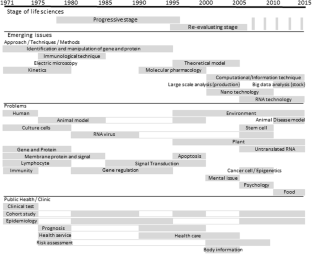
Similar content being viewed by others

Evaluating technological emergence using text analytics: two case technologies and three approaches
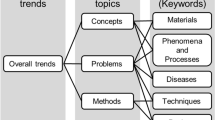
Researcher dynamics in the generation of emerging topics in life sciences and medicine
A systematic method to create search strategies for emerging technologies based on the web of science: illustrated for ‘big data’.
Batagelj, V., & Mrvar, A. (2002). Pajek—Analysis and visualization of large networks. Graph Drawing, 2265, 477–478.
Article Google Scholar
Borup, M., Brown, N., Konrad, K., & Van Lente, H. (2006). The sociology of expectations in science and technology. Technology Analysis & Strategic Management, 18 (3–4), 285–298. https://doi.org/10.1080/09537320600777002 .
Cozzens, S. E., Gatchair, S., Kang, J., Kim, K.-S., Lee, H. J., Ordónez, G., et al. (2010). Emerging technologies: Quantitative identification and measurement. Technology Analysis & Strategic Management, 22 (3), 361–376.
Daim, T. U., Rueda, G., Martin, H., & Gerdsri, P. (2006). Forecasting emerging technologies: Use of bibliometrics and patent analysis. Technological Forecasting and Social Change, 73 (8), 981–1012. https://doi.org/10.1016/j.techfore.2006.04.004 .
Furukawa, T., Mori, K., Arino, K., Hayashi, K., & Shirakawa, N. (2015). Identifying the evolutionary process of emerging technologies: A chronological network analysis of World Wide Web conference sessions. Technological Forecasting and Social Change, 91, 280–294. https://doi.org/10.1016/j.techfore.2014.03.013 .
Glanzel, W., & Thijs, B. (2012). Using ‘core documents’ for detecting and labelling new emerging topics. Scientometrics, 91 (2), 399–416. https://doi.org/10.1007/s11192-011-0591-7 .
Guo, H. N., Weingart, S., & Borner, K. (2011). Mixed-indicators model for identifying emerging research areas. Scientometrics , 89 (1), 421–435. https://doi.org/10.1007/s11192-011-0433-7 .
Jang, H. J., Woo, H. G., & Lee, C. (2017). Hawkes process-based technology impact analysis. Journal of Informetrics, 11 (2), 511–529. https://doi.org/10.1016/j.joi.2017.03.007 .
Lee, C., Kim, J., Kwon, O., & Woo, H. G. (2016). Stochastic technology life cycle analysis using multiple patent indicators. Technological Forecasting and Social Change, 106, 53–64. https://doi.org/10.1016/j.techfore.2016.01.024 .
Lee, C., Kwon, O., Kim, M., & Kwon, D. (2018). Early identification of emerging technologies: A machine learning approach using multiple patent indicators. Technological Forecasting and Social Change, 127, 291–303. https://doi.org/10.1016/j.techfore.2017.10.002 .
Lee, H. J., Lee, S., & Yoon, B. (2011). Technology clustering based on evolutionary patterns: The case of information and communications technologies. Technological Forecasting and Social Change, 78 (6), 953–967. https://doi.org/10.1016/j.techfore.2011.02.002 .
Leydesdorff, L., Rotolo, D., & Rafols, I. (2012). Bibliometric perspectives on medical innovation using the medical subject Headings of PubMed. Journal of the American Society for Information Science and Technology , 63 (11), 2239–2253. https://doi.org/10.1002/asi.22715 .
Lowe, H. J., & Barnett, G. O. (1994). Understanding and using the medical subject-headings (Mesh) vocabulary to perform literature searches. Journal of the American Medical Association , 271 (14), 1103–1108. https://doi.org/10.1001/jama.271.14.1103 .
Morris, S. A., Yen, G., Wu, Z., & Asnake, B. (2003). Time line visualization of research fronts. Journal of the American Society for Information Science and Technology, 54 (5), 413–422. https://doi.org/10.1002/asi.10227 .
Ohniwa, R. L., Hibino, A., & Takeyasu, K. (2010). Trends in research foci in life science fields over the last 30 years monitored by emerging topics. Scientometrics, 85 (1), 111–127. https://doi.org/10.1007/s11192-010-0252-2 .
Petersen, A. M., Rotolo, D., & Leydesdorff, L. (2016). A triple helix model of medical innovation: Supply, demand, and technological capabilities in terms of medical subject headings. Research Policy, 45 (3), 666–681. https://doi.org/10.1016/j.respol.2015.12.004 .
Rotolo, D., Hicks, D., & Martin, B. R. (2015). What is an emerging technology? Research Policy, 44 (10), 1827–1843. https://doi.org/10.1016/j.respol.2015.06.006 .
Shibata, N., Kajikawa, Y., Takeda, Y., Sakata, I., & Matsushima, K. (2011). Detecting emerging research fronts in regenerative medicine by the citation network analysis of scientific publications. Technological Forecasting and Social Change, 78 (2), 274–282. https://doi.org/10.1016/j.techfore.2010.07.006 .
Shin, J., Coh, B. Y., & Lee, C. (2013). Robust future-oriented technology portfolios: Black–Litterman approach. R&D Management, 43 (5), 409–419. https://doi.org/10.1111/radm.12022 .
Small, H., Boyack, K. W., & Klavans, R. (2014). Identifying emerging topics in science and technology. Research Policy, 43 (8), 1450–1467. https://doi.org/10.1016/j.respol.2014.02.005 .
van Lente, H., & Rip, A. (1998). The rise of membrane technology: From rhetorics to social reality. Social Studies of Science, 28 (2), 221–254. https://doi.org/10.1177/030631298028002002 .
Download references
Author information
Authors and affiliations.
Faculty of Medicine, University of Tsukuba, Tennoh-dai, Tsukuba, 305-8575, Japan
Ryosuke L. Ohniwa
Center for Biotechnology, National Taiwan University, Taipei, 106, Taiwan
Faculty of Humanities and Social Sciences, Hirosaki University, Hirosaki, 036-8560, Japan
Aiko Hibino
You can also search for this author in PubMed Google Scholar
Corresponding author
Correspondence to Ryosuke L. Ohniwa .
Electronic supplementary material
Below is the link to the electronic supplementary material.
11192_2019_3248_MOESM1_ESM.tif
The networks of the top 50 emerging keywords in 1971–1975. Only keywords that obtain links with other keywords are shown. The labels on the clusters represent the name of topics. The threshold for making edges was set as 10% of the number of keywords (selecting smaller sized nodes) linked by the edges. (TIFF 238 kb)
11192_2019_3248_MOESM2_ESM.tif
The networks of the top 50 emerging keywords in 1976–1980. See Supplemental Figure 1 legend for the conditions of links and labels. (TIFF 203 kb)
11192_2019_3248_MOESM3_ESM.tif
The networks of the top 50 emerging keywords in 1981–1985. See Supplemental Figure 1 legend for the conditions of links and labels. (TIFF 200 kb)
11192_2019_3248_MOESM4_ESM.tif
The networks of the top 50 emerging keywords in 1986–1990. See Supplemental Figure 1 legend for the conditions of links and labels. (TIFF 348 kb)
11192_2019_3248_MOESM5_ESM.tif
The networks of the top 50 emerging keywords in 1991–1995. See Supplemental Figure 1 legend for the conditions of links and labels. (TIFF 330 kb)
11192_2019_3248_MOESM6_ESM.tif
The networks of the top 50 emerging keywords in 1996–2000. See Supplemental Figure 1 legend for the conditions of links and labels. (TIFF 312 kb)
11192_2019_3248_MOESM7_ESM.tif
The networks of the top 50 emerging keywords in 2001–2005. See Supplemental Figure 1 legend for the conditions of links and labels. (TIFF 258 kb)
11192_2019_3248_MOESM8_ESM.tif
The networks of the top 50 emerging keywords in 2006–2010. See Supplemental Figure 1 legend for the conditions of links and labels. (TIFF 229 kb)
11192_2019_3248_MOESM9_ESM.tif
The networks of the top 50 emerging keywords in 2010–2015. See Supplemental Figure 1 legend for the conditions of links and labels. (TIFF 235 kb)
Rights and permissions
Reprints and permissions
About this article
Ohniwa, R.L., Hibino, A. Generating process of emerging topics in the life sciences. Scientometrics 121 , 1549–1561 (2019). https://doi.org/10.1007/s11192-019-03248-z
Download citation
Received : 14 March 2019
Published : 12 October 2019
Issue Date : December 2019
DOI : https://doi.org/10.1007/s11192-019-03248-z
Share this article
Anyone you share the following link with will be able to read this content:
Sorry, a shareable link is not currently available for this article.
Provided by the Springer Nature SharedIt content-sharing initiative
- Trends in life science
- Emerging topics
- Metrical index
- Find a journal
- Publish with us
- Track your research

189+ Top-Rated Life Science Research Topics For High School Students
Have you ever wondered about the incredible mysteries hidden within the world of living things? Life Science Research Topics for High School Students opens the door to exploring these amazing wonders! From understanding how our bodies work to exploring the diversity of life on Earth, these topics are like keys to unlock the secrets of biology, ecology, genetics, and much more.
In this fascinating journey, we get to investigate genes and how they affect our traits or even diseases we might inherit. Ever thought about how our environment impacts the way we grow and live? These topics will help us uncover the answers.
Delving into the realms of biology, we’ll explore ecosystems, creatures big and small, and even tiny microorganisms that play huge roles in our world. Ever pondered the science behind climate change or how pollution affects our planet? These research topics will guide us to understand these critical issues.
As budding scientists, we’ll dive into the science of life itself—learning about cells, organs, evolution, and even the fantastic world of biotechnology. So, are you ready to embark on this exciting research and exploration through Life Science Research Topics for High School Students?
You May Also Like To Know: Good Biology Topics to Research
Table of Contents
What Is Life Science Research Topics For High School Students?
Life Science Research Topics for High School Students refers to fascinating subjects that help students explore and study living things. These topics cover a wide range of areas, such as biology, genetics, ecology, and more. They are like doors that open to a world full of exciting discoveries about plants, animals, the human body, and even tiny microorganisms.
By diving into these topics, students get to learn about genes and how they affect our traits, as well as the environment’s role in shaping living organisms. These research topics also delve into how our actions impact the world around us, such as the effects of pollution or climate change.
In simple terms, Life Science Research Topics for High School Students are cool and interesting themes that allow students to learn about life on Earth in different ways. They encourage curiosity, investigation, and understanding about the living world we’re all a part of.
How Can I Choose And Find Good Ideas for Life Science Research Topics For High School Students?
Choosing and finding life science research topics for high school students can be an exciting journey! Here’s a guide to help you select an engaging topic:
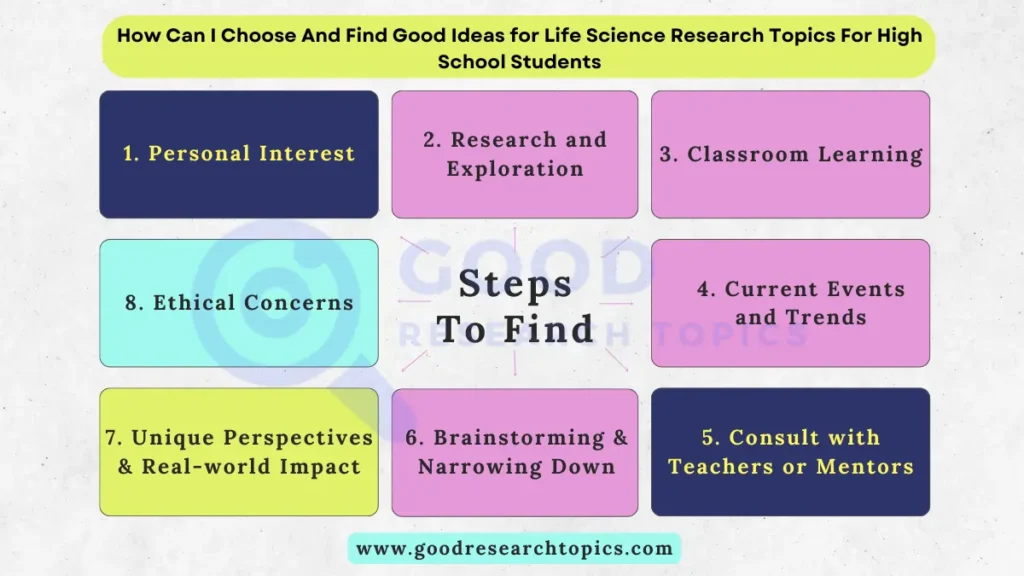
1. Personal Interest:
- Passion matters: Consider topics that genuinely interest you. Are you fascinated by genetics, ecology, human biology, or environmental issues? Start with what excites you.
2. Research and Exploration:
- Read and explore: Look through science magazines, online articles, and reputable websites. Explore recent scientific advancements and issues in biology or related fields.
3. Classroom Learning:
- Connect with lessons: Think about topics covered in your biology or science classes that piqued your curiosity. Topics discussed in class can be great starting points.
4. Current Events and Trends:
- Stay updated: Follow news related to biology, health, or the environment. Current events often spark research ideas.
5. Consult with Teachers or Mentors:
- Seek guidance: Your teachers or mentors can provide valuable advice. Discuss your interests and ask for suggestions or resources.
6. Brainstorming:
- Make a list: Write down ideas that come to mind. Even if they seem small or unusual, jot them down for consideration.
7. Narrowing Down:
- Research feasibility: Consider the availability of resources, time, and equipment. Ensure the topic is manageable for your level of study.
8. Unique Perspectives:
- Think differently: Consider approaching familiar topics from unique angles or explore interdisciplinary connections between biology and other subjects.
9. Real-world Impact:
- Consider relevance: Topics related to solving real-world problems or having practical applications can be highly engaging.
10. Ethical Considerations:
- Think about ethics: Some topics, such as genetic modification or animal testing, might have ethical implications. Consider these aspects when selecting your topic.
Great Examples of Life Science Research Topics
- Impact of climate change on a specific ecosystem
- Investigating the genetics of a hereditary disease
- Effects of different diets on human metabolism
- Role of microorganisms in environmental cleanup
- Study of biodiversity in a local habitat
- Analyzing the effectiveness of natural remedies in disease treatment
Some Examples Of Research Titles About Life, Physical, And Applied Science
Want to know What are some examples of research titles about life, physical, and applied science? Here are examples of research titles encompassing life science, physical science, and applied science:
Life Science Research Titles
- “Impact of Environmental Factors on Plant Growth and Development”
- “Genetic Variations in Disease Susceptibility: A Comparative Study”
- “Microbial Diversity in Different Soil Types and Its Implications”
- “Effects of Various Diets on Metabolic Rate in Drosophila melanogaster”
- “Understanding the Role of Gut Microbiota in Human Health”
Physical Science Research Titles
- “Investigation of Frictional Forces in Different Surfaces”
- “The Effect of Temperature Variations on the Rate of Chemical Reactions”
- “Exploring the Relationship Between Light Intensity and Solar Energy Production”
- “Analysis of Sound Waves and Their Applications in Communication”
- “Examining the Properties of Different Magnetic Materials”
Applied Science Research Titles
- “Design and Evaluation of a Water Filtration System Using Natural Materials”
- “Assessment of the Antibacterial Properties of Herbal Extracts for Wound Healing”
- “Development of a Sustainable Packaging Material from Biodegradable Sources”
- “Testing the Efficiency of Various Insulation Materials for Home Energy Conservation”
- “Design and Construction of a Solar-Powered Mobile Phone Charger”
List of Good Life Science Research Topics For High School Students
Here are 200+ research topics across various life science fields for high school students:
Genetics and Genomics Life Science Research Topics
- Study of hereditary diseases in specific populations
- Ethics of gene editing technologies (CRISPR/Cas9)
- Investigating genetic variations in response to environmental factors
- Role of epigenetics in gene expression and disease development
- Analysis of genetic mutations and their impact on health
Ecology and Environmental Biology Research Topics
- Impact of deforestation on local biodiversity
- Effects of climate change on migratory patterns of birds or animals
- Analysis of invasive species and their impact on ecosystems
- Investigating the correlation between urbanization and loss of biodiversity
- Importance of biodiversity in maintaining ecosystem stability
Physiology Life Science Research Topics For High School Students
- Comparative study of the digestive systems of different animals
- Effects of exercise on the cardiovascular system
- Investigating the impact of diet on metabolism and energy levels
- Neurological disorders: Causes and potential treatments
- Analysis of the respiratory system in relation to environmental factors
Evolutionary Biology Life Science Research Topics
- Comparative anatomy of vertebrates
- Investigating natural selection through a specific case study
- Analyzing fossil records to understand evolutionary changes
- Role of sexual selection in the evolution of specific traits
- Impact of environmental pressures on species adaptation
Microbiology Life Science Research Topics For High School Students
- Study of antibiotic resistance in bacteria
- Investigating the role of gut microbiota in human health
- Microorganisms in extreme environments: Adaptations and implications
- Analysis of viruses and their impact on global health
- Fermentation: Microbial processes and applications
Biotechnology Life Science Research Topics For Students
- Biotechnological applications in agriculture for enhanced crop yield
- Investigating the ethical considerations of cloning technologies
- Role of biotechnology in sustainable energy production
- CRISPR/Cas9: Precision gene editing and its potential applications
- Biopharmaceuticals: Production, benefits, and challenges
Recent Interesting Biochemistry & SIP Research Topics
- Enzyme kinetics and factors affecting enzyme activity
- Investigating the role of antioxidants in cellular health
- Biochemical processes involved in cellular aging
- Study of metabolic disorders and their biochemical basis
- Role of vitamins and minerals in human health and disease prevention
Life Science Research Topics Related To Protenomics and Molecular Biology
- Molecular basis of cancer and potential therapeutic targets
- Investigating gene regulation mechanisms using model organisms
- Study of protein folding and its implications in disease
- Analysis of DNA repair mechanisms and their significance
- Role of non-coding RNA in gene expression regulation
Biophysics Life Science Research Topics For High School Students
- Biomechanics of human movement and sports performance
- Investigating the physics of hearing or vision in organisms
- Biophysical properties of cell membranes and their functions
- Application of physics in medical imaging techniques
Climate Science Research Topics In Life Science
- Impact of climate change on marine ecosystems
- Investigating the role of permafrost in global climate change
- Analysis of climate models and their accuracy in predicting changes
- Renewable energy sources: Efficiency and potential improvements
- Impact of deforestation on regional climate patterns
Fun Life Science Research Topics For High School Students In Environmental Conservation
- Study of sustainable agricultural practices for soil conservation
- Investigating the role of wetlands in water purification
- Impact of plastic pollution on marine life and ecosystems
- Analysis of wildlife conservation strategies in specific regions
- Importance of biodiversity conservation in urban areas
Cool Pollution and Remediation Life Science Research Topics
- Investigating air pollution sources and their health effects
- Water pollution: Causes, effects, and potential solutions
- Analysis of industrial pollution control technologies
- Role of plants in phytoremediation of contaminated environments
- Impact of noise pollution on wildlife and human health
Genetics and Genomics Life Science Research Topics For High School Students
- Investigating genetic disorders in specific ethnic populations
- Gene editing technologies: Ethical considerations and limitations
- Environmental factors and their influence on gene expression
- Epigenetics: Role in inheritance and disease development
- Analysis of genetic mutations and their implications in human health
Ecology and Environmental Biology Life Science Research Topics
- Impact of habitat fragmentation on biodiversity
- Effects of climate change on species extinction rates
- Study of keystone species and their importance in ecosystems
- Investigating the effects of pollution on local wildlife
- Ecological succession: Case studies in different environments
- Comparative study of the respiratory systems in mammals
- Effects of various diets on metabolic rates in humans
- Investigating the neurobiology of learning and memory
- Analysis of hormonal regulation in different life stages
- Cardiovascular diseases: Risk factors and preventive measures
Life Science Research Topics & Title Ideas For Evolutionary Biology
- Comparative embryology across different species
- Investigating convergent evolution in unrelated species
- Study of genetic drift in isolated populations
- Role of symbiosis in evolutionary relationships
- Impact of human activities on rapid evolution in certain species
- Study of the human microbiome and its significance
- Investigating the role of viruses in ecosystem dynamics
- Microbial interactions in soil ecosystems
- Analysis of bioremediation techniques using microorganisms
- Role of microbes in food production and preservation
Lastest Biotechnology Life Science Research Topics
- Applications of biotechnology in disease diagnosis
- Investigating ethical considerations in genetically modified organisms (GMOs)
- Role of biotechnology in renewable energy production
- Bioprospecting: Exploring natural sources for biotechnological applications
- Synthetic biology: Challenges and future prospects
Best Life Science Research Topics For High School Students In Biochemistry
- Study of enzyme kinetics and substrate specificity
- Investigating metabolic pathways in specific diseases
- Biochemical basis of neurodegenerative diseases
- Analysis of protein structure-function relationships
- Role of vitamins and minerals in cellular metabolism
Protenomics and Molecular Biology Research Topics
- Investigating genetic regulation using model organisms
- Role of non-coding RNA in gene expression modulation
- Study of molecular mechanisms underlying cell division
- Analysis of DNA damage and repair mechanisms
- Molecular basis of infectious diseases and host-pathogen interactions
- Biomechanics of animal locomotion and adaptations
- Investigating the physics of sensory perception in organisms
- Application of physics in medical imaging and diagnostics
Cool Life Science Research Topics For High School Students In Climate Science
- Impact of climate change on global food security
- Investigating feedback loops in climate change models
- Analysis of climate data and its implications for future predictions
- Renewable energy technologies: Advancements and limitations
- Urban heat island effect: Causes and potential mitigation strategies
Environmental Conservation Life Science Research topics
- Study of sustainable forestry practices for biodiversity conservation
- Investigating the role of coral reefs in coastal protection
- Impact of human activities on freshwater ecosystems
- Analysis of wildlife conservation strategies in urban environments
- Importance of community involvement in conservation efforts
Pollution and Remediation Life Science Research Topics For High School Students
- Investigating the sources and effects of light pollution
- Water pollution: Case studies and remediation strategies
- Analysis of bioaccumulation and biomagnification of pollutants
- Role of microbial communities in environmental cleanup
- Noise pollution: Effects on wildlife behavior and ecosystems

Genetics and Genomics Research Topics In Life Science
- Investigating epigenetic modifications in cancer development
- Gene editing technologies: Applications in agriculture
- Study of gene-environment interactions in complex diseases
- Role of genetic counseling in managing hereditary disorders
- Analysis of genetic diversity in endangered species
- Impact of climate change on plant-pollinator interactions
- Investigating the effects of habitat fragmentation on migratory species
- Study of ecosystem resilience in the face of environmental disturbances
- Role of conservation genetics in endangered species management
- Analysis of the ecological consequences of invasive species
- Comparative study of endocrine systems in different species
- Effects of sleep deprivation on cognitive functions
- Investigating the physiological adaptations of extremophiles
- Analysis of nutritional requirements in different life stages
- Impact of environmental pollutants on hormonal balance
Hot Evolutionary Biology Life Science Research Topics
- Comparative genomics in understanding evolutionary relationships
- Investigating evolutionary adaptations in extremophiles
- Study of co-evolution between hosts and parasites
- Role of epistasis in shaping evolutionary trajectories
- Impact of human activities on rapid evolution in pathogens
Microbiology Life Science Research Topics For Students
- Study of antibiotic resistance mechanisms in bacteria
- Investigating microbial communities in extreme environments
- Microbial biogeography: Distribution patterns and factors
- Analysis of microbial diversity in soil ecosystems
- Role of microbiota in human immune system development
Life Science Research Topics For High School Students In Biotechnology
- Applications of biotechnology in personalized medicine
- Investigating ethical considerations in gene therapy
- Role of biotechnology in sustainable agriculture
- Bioremediation: Biotechnological approaches for environmental cleanup
- Synthetic biology: Engineering novel biological systems
Biochemistry Life Science Research Topics For High School Students
- Study of enzyme kinetics and allosteric regulation
- Investigating metabolic flux analysis in cellular metabolism
- Biochemical basis of neurodevelopmental disorders
- Analysis of post-translational modifications in proteins
- Role of vitamins and minerals as enzyme cofactors
- Investigating gene expression regulation in development
- Role of non-coding RNAs in epigenetic regulation
- Study of DNA replication and repair mechanisms
- Analysis of molecular mechanisms underlying cell signaling
- Molecular basis of host-pathogen interactions
- Biomechanics of plant movements and growth
- Investigating the physics of cell division and mitosis
- Biophysical properties of biomolecules and their functions
- Application of physics in understanding biological rhythms
Life Science Research Topics For College Students
- Impact of climate change on ocean acidification
- Investigating the role of aerosols in climate dynamics
- Analysis of extreme weather events and their trends
- Renewable energy technologies: Challenges and advancements
- Carbon footprint assessment and reduction strategies
Easy Life Science Research Topics
- Study of ecosystem services and their valuation
- Investigating the impact of deforestation on soil erosion
- Role of restoration ecology in habitat rehabilitation
- Analysis of the effects of overfishing on marine ecosystems
- Importance of green infrastructure in urban conservation
list of Interesting Life Science Research Topics About Agriculture
- Investigating the sources and effects of plastic pollution
- Soil pollution: Case studies and remediation techniques
- Analysis of emerging contaminants in the environment
- Role of bioreactors in treating wastewater
- Impact of electromagnetic pollution on ecosystems
Life Science Research Topics For High School Students Quantitative
- Investigating gene expression regulation in developmental disorders
- Gene editing technologies: Ethical considerations in human applications
Ecology and Science Investigation Research Topics For Plants
List of life science research topics for high school students in philippines, evolutionary biology life science title ideas for students, microbiology life science research topics for college students, highly recommended biotechnology life science topics, biochemistry life science research topics for school students, protenomics and molecular biology, biophysics life science research topics for undergraduate students, life science research paper topics, plant research topics in life science, interesting biology topics for project, list of great life science research topics pdf.
Here are the Life Science Research Topics For Students PDF.
What Are The Good Research Topics For A High Schooler Related To Life Science, Physical Science, Applied Science, Or Material Science That Can Be Done At Home?
Here are the research topics for high schoolers related to life science, physical science, applied science, and material science that can be conducted at home:
Final Words – Life Science Research Topics For High School Students
Life Science Research Topics for High School Students offer an incredible glimpse into the captivating world of living organisms and the environment that surrounds us. Through these explorations, we’ve uncovered fascinating aspects of genetics, ecology, physiology, evolution, microbiology, and biotechnology.
As we conclude this journey, remember that these topics serve as stepping stones for further inquiry and discovery. They have unveiled the complexities of life, inspiring us to delve deeper into understanding the intricacies of our bodies, the diversity of species, and the interconnectedness of all living things.
Each investigation has broadened our horizons, enabling us to comprehend the impact of human actions on the environment and the significance of conservation efforts. These research topics have fueled our curiosity, encouraging us to be proactive stewards of our planet and advocates for scientific progress and sustainability.
As we bid farewell to this exploration, let’s carry forward the spirit of curiosity and inquiry, continuing to unravel the mysteries of life and contributing to the collective knowledge that shapes our understanding of the natural world. Remember, the journey of scientific discovery never truly ends—it evolves, grows, and awaits your continued exploration and contribution.
Related Posts

100+ Most Qualitative Research Topics For High School Students In 2024

100+ Most Interesting Google Scholar Research Topics For Students [Updated 2024]
Leave a comment cancel reply.
Your email address will not be published. Required fields are marked *
Save my name, email, and website in this browser for the next time I comment.
Premium accounts now available! Sign up and create a premium account. Read more Life Science Network Close
Life Science Network
Search Search
Your cookie settings
This site uses cookies. Some cookies are essential to make the site work and others help up to improve our services. Read more about cookies in our Privacy policy .
Choose your cookie preferences:
- Essential (mandatory, cannot be disabled)
- Analytics (recommended, but not essential, can be disabled)
Publications
Life Science Network features a scientific publication module you can use to share your research in life sciences and related disciplines. The module integrates post-publication review features. Publications can be uploaded or imported from PubMed.
For latest content published in some of the most popular scientific journals, check our Journal content module.
You can upload a publication here
Search Submit
This list contains publications from the last 7 days only. Use the search function to access older publications.
The default sorting of articles in this list is by the date when the article was uploaded or imported to our database (shown on top). Publication date is indicated below the title.
Created May 11, 2024
Efficient Catalytic Elimination of Toxic Volatile Organic Compounds via Advanced Oxidation Process Wet Scrubbing with Bifunctional Cobalt Sulfide/Activated Carbon Catalysts.
by Yongjie Xiang, Xiaowen Xie, Huanran Zhong, Fei Xiao, Ruijie Xie, Biyuan Liu, Hao Guo, Di Hu, Pan Zhang, Haibao Huang — Environmental science & technology. May 10, 2024.
- Report or request
Discovery of Potent Glycosidases Enables Quantification of Smoke-Derived Phenolic Glycosides through Enzymatic Hydrolysis.
by Youtian Cui, Mary Riley, Marcus V Moreno, Mateo M Cepeda, Ignacio Arias Perez, Yan Wen, Lik Xian Lim, Eric Andre, An Nguyen, Cody Liu, Larry Lerno, Patrick K Nichols, Harold Schmitz, Ilias Tagkopoulos, James A Kennedy, Anita Oberholster, Justin B Siegel — Journal of agricultural and food chemistry. May 10, 2024.
Atomic-Scale Interface for Pt Nanoparticles on SrTiO 3 (001).
by Yanna Chen, Anusheela Das, Isaiah D Duplessis, Denis T Keane, Michael J Bedzyk — ACS applied materials & interfaces. May 10, 2024.
United States Medical Licensing Examination Performance and Outcomes of Patient Care.
by Allan R Tunkel — Academic medicine : journal of the Association of American Medical Colleges. May 10, 2024.
Ionic Liquid Modified Fe-Porphyrinic Metal-Organic Frameworks as Efficient and Selective Photocatalysts for CO 2 Reduction.
by Xue Zhao, Qiang Xu, Jingwei Han, Wenwen Zhang, Heng Rao, Dong-Ying Du, Ping She, Jun-Sheng Qin — ACS applied materials & interfaces. May 10, 2024.
A laser-Engraved Wearable Electrochemical Sensing Patch for Heat Stress Precise Individual Management of Horse.
by Yuxiang Pan, Xiaoyu Su, Ying Liu, Peidi Fan, Xunjia Li, Yibin Ying, Jianfeng Ping — Advanced science (Weinheim, Baden-Wurttemberg, Germany). Pages e2310069. May 10, 2024.
Centrifugal-Gravity-Enforced Deposition of MXene Electrodes for High-Performance and Ultrastable Microsupercapacitors.
by Dawoon Lee, Eunji Kim, Chi Won Ahn, Yonghee Lee, U Hyeok Choi, Jaekyun Kim — ACS applied materials & interfaces. May 10, 2024.
Specific Small-Molecule Detection Using Designed Nucleic Acid Nanostructure Carriers and Nanopores.
by Zhipeng Xie, Zihao Chen, Aijia Li, Bing Huang, Cunlan Guo, Yueming Zhai — Analytical chemistry. May 10, 2024.
Mitigating Strain Accumulation in Li 2 RuO 3 via Fluorine Doping.
by Yanfang Wang, Hongzhi Wang, Yongcong Huang, Yingzhi Li, Zongrun Li, Joshua W Makepeace, Quanbing Liu, Fucai Zhang, Phoebe K Allan, Zhouguang Lu — The journal of physical chemistry letters. Pages 5359-5365. May 10, 2024.
Destabilization of Oxidized Lattice Oxygen in Layered Oxide Cathode.
by Chunjing Hu, Xiaobing Lou, Xiang Wu, Jingxin Li, Zhenhuang Su, Nian Zhang, Jiong Li, Bingwen Hu, Chao Li — ACS nano. May 10, 2024.
Please sign up with LSN to view all content. If you already have an LSN, Linkedin or Google account:
Loading ad...

[100+] Life Science Topics With Free [Thesis Pdf] 2023
Are You Searching Research Topics For Life Science , Topics For Life Science Research Paper, Life Science Research Topics For Students, Research Topics Ideas For Life Science, Life Science Research Topics For PhD, Life Science PhD Topics. So You are in right place.
In this article, we provide you latest research topics for Life Science with a full Phd thesis. By these research topics for Life Science you can get idea for your research work. On this website, you can get lots of Life Science Research Topics for College Students, PhD, Mphil, Dissertations, Thesis, Project, Presentation, Seminar or Workshop. Check the suggestions below that can help you choose the right research topics for Life Science: You can also Free Download Life Science Research PhD Thesis in Pdf by the given link.
Now Check 100+ Life Science Research Topics List
Table of Contents
Research Topic For Life Science 2023
Life science research topics for dissertation, research topics ideas for life science, life science research topics ideas for college students, topics for life science research paper, life science research topics for thesis, life science research topics for students, life science research topics for undergraduate students, life science research topics for university students, life science research topics for phd, research topics for phd in life science, research topics for mphil life science, life science phd topics, research paper topics for life science, life science research paper topics, phd thesis topic for life science, research topics for life science subject, life science research topics for fisheries, research topics for life science, life science research topics examples.
Note: All Research Work Idea on this website is inspired by Shodhganga: a reservoir of Indian Theses. We provide you mostly research work under Creative Commons Licence. Credit goes to https://shodhganga.inflibnet.ac.in/
If you find any copyright content on this website and you have any objection than plz immediately connect us on [email protected]. We Will remove that content as soon as.
This Post is also helpful for: Life Science Thesis Pdf, Life Science Thesis Topics, Life Science Dissertation Topics, Life Science Thesis, Catchy Title For Life Science, Phd Thesis Topic for Life Science, Life Science Research Paper Topics, Life Science Phd Topics, Life Science Research Topics, Research Topics For Life Science Students in India, Life Science Research Topics For College Students.
7 thoughts on “[100+] Life Science Topics With Free [Thesis Pdf] 2023”
- Pingback: Home - Research Scholar
- Pingback: Home Page 3 - Research Scholar
- Pingback: How To Write Master Thesis Pdf: Step By Step Example and Quickly Tips - Research Scholar
- Pingback: How To Do Research in Law 2023 - Research Scholar
- Pingback: How To Do Research in Biotechnology 2023 - Research Scholar
- Pingback: How To Do Research in Sociology 2023 - Research Scholar
- Pingback: How To Do Research in Medical 2023 - Research Scholar
Leave a Comment Cancel reply
Save my name, email, and website in this browser for the next time I comment.
Thank you for visiting nature.com. You are using a browser version with limited support for CSS. To obtain the best experience, we recommend you use a more up to date browser (or turn off compatibility mode in Internet Explorer). In the meantime, to ensure continued support, we are displaying the site without styles and JavaScript.
- View all journals
- Explore content
- About the journal
- Publish with us
- Sign up for alerts
Collection 15 July 2019
Top 50: Life and Biological Sciences
We are pleased to share with you the 50 most read Nature Communications life and biological sciences articles* published in 2018. Featuring authors from around the world, these papers highlight valuable research from an international community.
Browse all Top 50 subject area collections here .
*Based on data from altmetric.com , covering January-December 2018

Embryos and embryonic stem cells from the white rhinoceros
The Southern (SWR) and Northern (NWR) are two subspecies of the White Rhinoceros with the NWR being almost extinct. Here, using assisted reproduction technology, the authors produce and cryopreserve SWR purebred and NWR-SWR hybrid embryos developed to the blastocyst stage, and also generate embryonic stem cell lines, in an attempt to save genes of the NWR.
- Thomas B. Hildebrandt
- Robert Hermes
- Cesare Galli
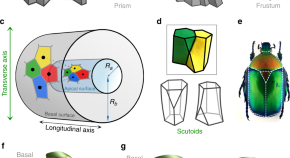
Scutoids are a geometrical solution to three-dimensional packing of epithelia
Cell arrangement in the plane of epithelia is well studied, but its three-dimensional packing is largely unknown. Here the authors model curved epithelia and predict that cells adopt a geometrical shape they call “scutoid”, resulting in different apical and basal neighbours, and confirm the presence of scutoids in curved tissues.
- Pedro Gómez-Gálvez
- Pablo Vicente-Munuera
- Luis M. Escudero

Similar neural responses predict friendship
Though we are often friends with people similar to ourselves, it is unclear if neural responses to perceptual stimuli are also similar. Here, authors show that the similarity of neural responses evoked by a range of videos was highest for close friends and decreased with increasing social distance.
- Carolyn Parkinson
- Adam M. Kleinbaum
- Thalia Wheatley
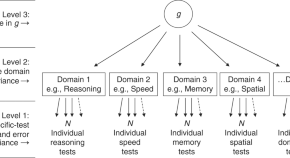
Study of 300,486 individuals identifies 148 independent genetic loci influencing general cognitive function
Cognitive function is associated with health and important life outcomes. Here, the authors perform a genome-wide association study for general cognitive function in 300,486 individuals and identify genetic loci that implicate neural and cell developmental pathways in this trait.
- Gail Davies
- Ian J. Deary
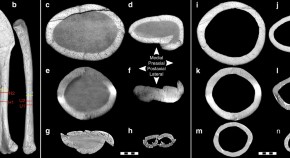
Wing bone geometry reveals active flight in Archaeopteryx
Archaeopteryx had a mix of traits seen in non-flying dinosaurs and flying birds, leading to debate on whether it had powered flight. Here, Voeten et al. compare wing bone architecture from Archaeopteryx and both flying and non-flying archosaurs, supporting that Archaeopteryx had powered flight but with a different stroke than that of modern birds.
- Dennis F. A. E. Voeten
- Sophie Sanchez

Hunting regulation favors slow life histories in a large carnivore
Hunting and harvesting are generally expected to select for faster life histories in the exploited species. Here, the authors analyse data from a hunted population of brown bears in Sweden and show that regulations protecting females with dependent young lead hunting to favor prolonged maternal care.
- Joanie Van de Walle
- Gabriel Pigeon
- Fanie Pelletier

Closed-loop stimulation of temporal cortex rescues functional networks and improves memory
Memory lapses can occur due to ineffective encoding, but it is unclear if targeted brain stimulation can improve memory performance. Here, authors use a closed-loop system to decode and stimulate periods of ineffective encoding, showing that stimulation of lateral temporal cortex can enhance memory.
- Youssef Ezzyat
- Paul A. Wanda
- Michael J. Kahana
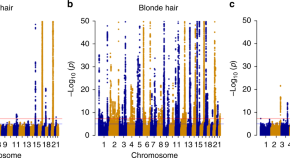
Genome-wide study of hair colour in UK Biobank explains most of the SNP heritability
Natural hair colour in Europeans is a complex genetic trait. Here, the authors carry out a genome-wide association study using UK BioBank data, suggesting that in combination with pigmentation genes, variants with roles in hair texture and growth can affect hair colouration or our perception of it.
- Michael D. Morgan
- Erola Pairo-Castineira
- Ian J. Jackson
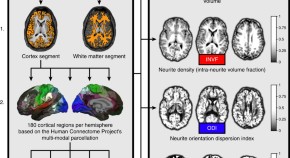
Diffusion markers of dendritic density and arborization in gray matter predict differences in intelligence
Previous studies suggest that individual differences in intelligence correlate with circuit complexity and dendritic arborization in the brain. Here the authors use NODDI, a diffusion MRI technique, to confirm that neurite density and arborization are inversely related to measures of intelligence.
- Christoph Fraenz
- Rex E. Jung
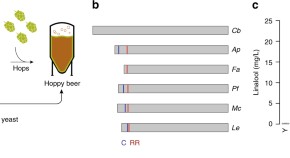
Industrial brewing yeast engineered for the production of primary flavor determinants in hopped beer
Production of aromatic monoterpene molecules in hop flowers is affected by genetic, environmental, and processing factors. Here, the authors engineer brewer’s yeast for the production of linalool and geraniol, and show pilot-scale beer produced by engineered strains reconstitutes some qualities of hop flavor.
- Charles M. Denby
- Rachel A. Li
- Jay D. Keasling
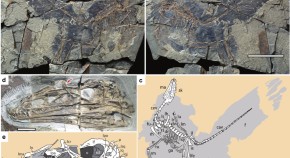
A bony-crested Jurassic dinosaur with evidence of iridescent plumage highlights complexity in early paravian evolution
A number of paravian dinosaurs have been described from the Jurassic Yanliao biota, but these have tended to be morphologically similar to Archaeopteryx . Here, Hu. describe the new paravian dinosaur, Caihong juji gen. et sp. nov., which possesses a suite of unusual skeletal and feather characteristics.
- Julia A. Clarke
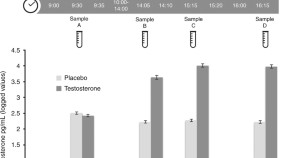
Single-dose testosterone administration increases men’s preference for status goods
Testosterone is believed to be involved in social rank-related behavior. Here, the authors show that one dose of testosterone increases men’s preference for “high status” goods and brands, suggesting a role for testosterone in modern consumer behavior in men.
- H. Plassmann
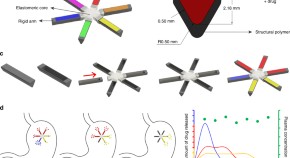
Development of an oral once-weekly drug delivery system for HIV antiretroviral therapy
Poor adherence to daily antiretrovirals can significantly affect treatment efficacy, but oral long-acting antiretrovirals are currently lacking. Here, the authors develop a once-weekly oral dosage form for anti-HIV drugs, assess its pharmacokinetics in pigs, and model its impact on viral resistance and disease epidemics.
- Ameya R. Kirtane
- Omar Abouzid
- Giovanni Traverso

Smartphone app for non-invasive detection of anemia using only patient-sourced photos
Anemia has a global prevalence of over 2 billion people and is diagnosed via blood-based laboratory test. Here the authors describe a smartphone app that can estimate hemoglobin levels and detect anemia by analyzing pictures of fingernail beds taken with a smartphone and without the need of any external equipment.
- Robert G. Mannino
- David R. Myers
- Wilbur A. Lam
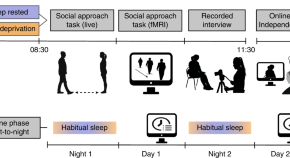
Sleep loss causes social withdrawal and loneliness
Loneliness markedly increases mortality and morbidity, yet the factors triggering loneliness remain largely unknown. This study shows that sleep loss leads to a neurobehavioral phenotype of human social separation and loneliness, one that is transmittable to non-sleep-deprived individuals.
- Eti Ben Simon
- Matthew P. Walker
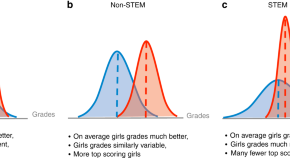
Gender differences in individual variation in academic grades fail to fit expected patterns for STEM
Men are over-represented in the STEM (science, technology, engineering and mathematics) workforce even though girls outperform boys in these subjects at school. Here, the authors cast doubt on one leading explanation for this paradox, the ‘variability hypothesis’.
- R. E. O’Dea
- S. Nakagawa
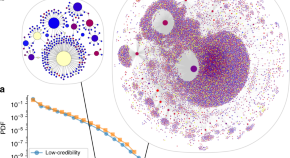
The spread of low-credibility content by social bots
Online misinformation is a threat to a well-informed electorate and undermines democracy. Here, the authors analyse the spread of articles on Twitter, find that bots play a major role in the spread of low-credibility content and suggest control measures for limiting the spread of misinformation.
- Chengcheng Shao
- Giovanni Luca Ciampaglia
- Filippo Menczer

Tailed giant Tupanvirus possesses the most complete translational apparatus of the known virosphere
Giant viruses are the largest viruses of the known virosphere and their genetic analysis can provide insights into virus evolution. Here, the authors discover Tupanvirus, a unique giant virus that has an unusually long tail and contains the largest translational apparatus of the known virosphere.
- Jônatas Abrahão
- Lorena Silva
- Bernard La Scola
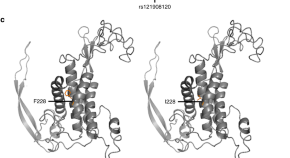
Genome-wide meta-analysis implicates mediators of hair follicle development and morphogenesis in risk for severe acne
Acne vulgaris is a chronic inflammation of the skin, the genetic basis of which is incompletely understood. Here, Petridis et al. perform GWAS and meta-analysis for acne in 26,722 individuals and identify 12 novel risk loci that implicate structure and maintenance of the skin in severe acne risk.
- Christos Petridis
- Alexander A. Navarini
- Michael A. Simpson
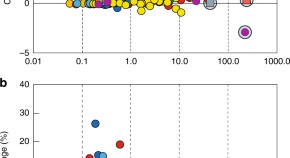
Patterns of island change and persistence offer alternate adaptation pathways for atoll nations
Inundation and erosion could make many atoll islands uninhabitable over the next century. Here the authors present an analysis of change in the atoll nation of Tuvalu that shows a 2.9% increase in land area over the past four decades, with 74% of islands increasing in size, despite rising sea levels.
- Paul S. Kench
- Murray R. Ford
- Susan D. Owen

Blood–brain barrier opening in Alzheimer’s disease using MR-guided focused ultrasound
Magnetic resonance-guided focused ultrasound with injected microbubbles has been used to temporarily open the blood–brain barrier (BBB) in animal models of Alzheimer's disease (AD). Here, the authors use this technology to non-invasively open the BBB in 5 patients with mild-to-moderate AD in a phase I trial, and show that the procedure is safe.
- Nir Lipsman
- Sandra E. Black
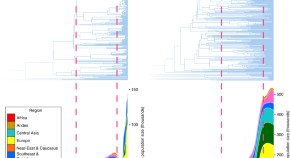
Cultural hitchhiking and competition between patrilineal kin groups explain the post-Neolithic Y-chromosome bottleneck
A population bottleneck 5000-7000 years ago in human males, but not females, has been inferred across several African, European and Asian populations. Here, Zeng and colleagues synthesize theory and data to suggest that competition among patrilineal kin groups produced the bottleneck pattern.
- Tian Chen Zeng
- Marcus W. Feldman
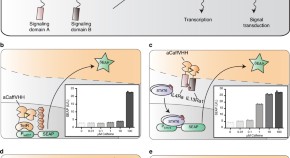
Caffeine-inducible gene switches controlling experimental diabetes
Control of transgene expression should ideally be easy and with minimal side effects. Here the authors present a synthetic biology-based approach in which the caffeine in coffee regulates a genetic circuit controlling glucagon-like peptide 1 expression in diabetic mice.
- Daniel Bojar
- Leo Scheller
- Martin Fussenegger
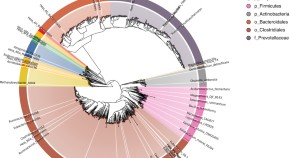
Assembly of 913 microbial genomes from metagenomic sequencing of the cow rumen
Microbes in the cow rumen are crucial for the breakdown of plant material. Here, Stewart et al. assemble over 900 bacterial and archaeal genomes from the cow rumen microbiome, revealing new species and genes encoding enzymes with potential roles in carbohydrate metabolism.
- Robert D. Stewart
- Marc D. Auffret
- Mick Watson
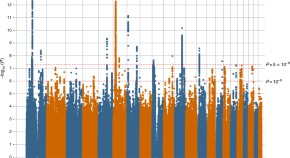
Genome-wide association study of depression phenotypes in UK Biobank identifies variants in excitatory synaptic pathways
The UK Biobank provides data for three depression-related phenotypes. Here, Howard et al. perform a genome-association study for broad depression, probable major depressive disorder (MDD) and hospital record-coded MDD in up to 322,580 UK Biobank participants which highlights excitatory synaptic pathways.
- David M. Howard
- Mark J. Adams
- Andrew M. McIntosh
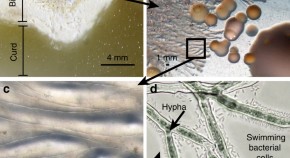
Fungal networks shape dynamics of bacterial dispersal and community assembly in cheese rind microbiomes
Interactions with other microbes may inhibit or facilitate the dispersal of bacteria. Here, Zhang et al. use cheese rind microbiomes as a model to show that physical networks created by filamentous fungi can affect the dispersal of motile bacteria and thus shape the diversity of microbial communities.
- Yuanchen Zhang
- Erik K. Kastman
- Benjamin E. Wolfe
Epidemiology is a science of high importance
Epidemiology dates back to the Age of Pericles in 5th Century B.C., but its standing as a ‘true’ science in 21st century is often questioned. This is unexpected, given that epidemiology directly impacts lives and our reliance on it will only increase in a changing world.
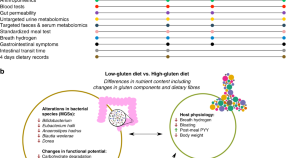
A low-gluten diet induces changes in the intestinal microbiome of healthy Danish adults
Gluten-free diets are increasingly common in the general population. Here, the authors report the results of a randomised cross-over trial involving middle-aged, healthy Danish adults, showing evidence that a low-gluten diet leads to gut microbiome changes, possibly due to variations in dietary fibres.
- Lea B. S. Hansen
- Henrik M. Roager
- Oluf Pedersen

In utero nanoparticle delivery for site-specific genome editing
The correction of genetic defects in utero could allow for improved outcomes of gene therapy. Here, the authors demonstrate safe delivery of nanoparticles to fetal mouse tissues, and show that nanoparticles containing peptide nucleic acids to edit the beta-globin gene are effective in a mouse model of beta-thalassemia.
- Adele S. Ricciardi
- Raman Bahal
- W. Mark Saltzman
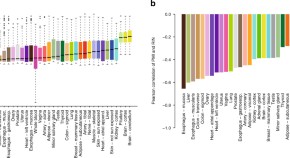
The effects of death and post-mortem cold ischemia on human tissue transcriptomes
RNA levels in post-mortem tissue can differ greatly from those before death. Studying the effect of post-mortem interval on the transcriptome in 36 human tissues, Ferreira et al. find that the response to death is largely tissue-specific and develop a model to predict time since death based on RNA data.
- Pedro G. Ferreira
- Manuel Muñoz-Aguirre
- Roderic Guigó

Gimap5-dependent inactivation of GSK3β is required for CD4 + T cell homeostasis and prevention of immune pathology
Loss of function GIMAP5 mutation is associated with lymphopenia, but how it mediates T cell homeostasis is unclear. Here the authors study Gimap5 −/− mice and a patient with GIMAP5 deficiency to show how this GTPAse negatively regulates GSK3β activity to prevent DNA damage and cell death.
- Andrew R. Patterson
- Mehari Endale
- Kasper Hoebe
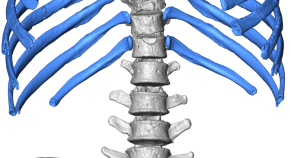
3D virtual reconstruction of the Kebara 2 Neandertal thorax
How different Neandertal morphology was from that of modern humans has been a subject of long debate. Here, the authors develop a 3D virtual reconstruction of the thorax of an adult male Neandertal, showing similar size to modern humans, yet with greater respiratory capacity due to its different shape.
- Asier Gómez-Olivencia
- Alon Barash
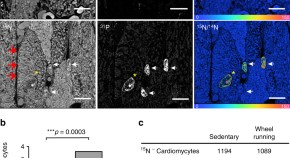
Exercise induces new cardiomyocyte generation in the adult mammalian heart
The adult mammalian heart has a limited cardiomyogenic capacity. Here the authors show that intensive exercise leads to a 4.6-fold increase in murine cardiomyocyte proliferation requiring the expression of miR-222, and that exercise induces an extended cardiomyogenic response in the murine heart after infarction.
- Carolin Lerchenmüller
- Anthony Rosenzweig
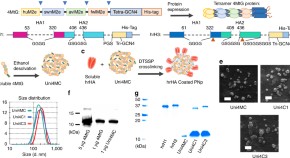
Double-layered protein nanoparticles induce broad protection against divergent influenza A viruses
Relatively well conserved domains of influenza A virus (IAV) proteins are potential candidates for the development of a universal IAV vaccine. Here, Deng et al . combine two such conserved antigens (M2e and HA stalk) in a double-layered protein nanoparticle and show that it protects against divergent IAVs in mice.
- Teena Mohan
- Bao-Zhong Wang
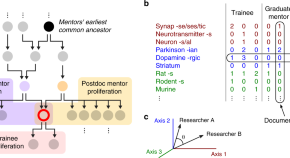
Intellectual synthesis in mentorship determines success in academic careers
While successful mentors tend to train successful students in academic career, it’s unclear how mentorship determines chances of a success in a trainee. Here, Liénard and colleagues analyze approximately 20 K mentor/trainee relationships in life sciences, and find that success of trainees is associated with an intellectual synthesis between their mentors’ research.
- Jean F. Liénard
- Titipat Achakulvisut
- Stephen V. David
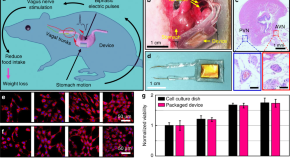
Effective weight control via an implanted self-powered vagus nerve stimulation device
Developing new technologies for the neuromodulation of the vagus nerve can enable therapeutic strategies for body weight control in obese patients. Here, the authors present a battery-free self-powered implantable vagus nerve stimulation system that electrically responds to stomach movement.
- Xudong Wang
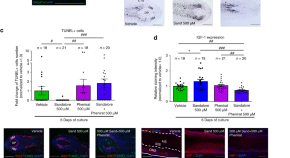
Olfactory receptor OR2AT4 regulates human hair growth
Increasing evidence suggest that olfactory receptors can carry additional functions besides olfaction. Here, Chéret et al. show that stimulation of the olfactory receptor ORT2A4 by the odorant Sandalore ® stimulates growth of human scalp hair follicles ex vivo, suggesting the use of ORT2A4-targeting odorants as hair growth-promoting agents.
- Jérémy Chéret
- Marta Bertolini
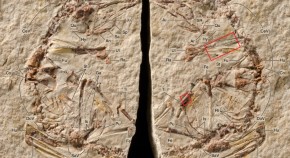
A diminutive perinate European Enantiornithes reveals an asynchronous ossification pattern in early birds
Fossil juvenile Mesozoic birds are exceedingly rare and can provide important insight into the early evolution of avian development. Here, Knoll et al. describe one of the smallest known Mesozoic avians, which indicates a clade-wide asynchronous pattern of osteogenesis and great variation in basal bird hatchling size and skeletal maturation tempo.
- Fabien Knoll
- Luis M. Chiappe
- Jose Luis Sanz
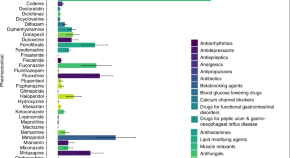
A diverse suite of pharmaceuticals contaminates stream and riparian food webs
Pharmaceuticals are widespread contaminants in surface waters. Here, Richmond and colleagues show that dozens of pharmaceuticals accumulate in food chains of streams, including in predators in adjacent terrestrial ecosystems.
- Erinn K. Richmond
- Emma J. Rosi
- Michael R. Grace
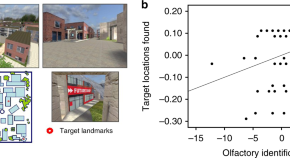
An intrinsic association between olfactory identification and spatial memory in humans
Olfaction, the sense of smell, may have originally evolved to aid navigation in space, but there is no direct evidence of a link between olfaction and navigation in humans. Here the authors show that olfaction and spatial memory abilities are correlated and rely on similar brain regions in humans.
- Louisa Dahmani
- Raihaan M. Patel
- Véronique D. Bohbot
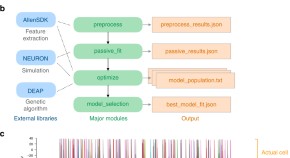
Systematic generation of biophysically detailed models for diverse cortical neuron types
Neocortical circuits exhibit diverse cell types that can be difficult to build into computational models. Here the authors employ a genetic algorithm-based parameter optimization to generate multi-compartment Hodgkin-Huxley models for diverse cell types in the Allen Cell Types Database.
- Nathan W. Gouwens
- Anton Arkhipov
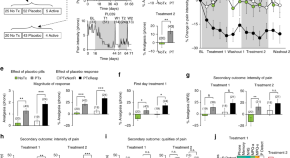
Brain and psychological determinants of placebo pill response in chronic pain patients
People vary in the extent to which they feel better after taking an inert, placebo, treatment, but the basis for individual placebo response is unclear. Here, the authors show how brain structural and functional variables, as well as personality traits, predict placebo response in those with chronic back pain.
- Etienne Vachon-Presseau
- Sara E. Berger
- A. Vania Apkarian
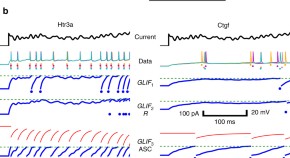
Generalized leaky integrate-and-fire models classify multiple neuron types
Simplified neuron models, such as generalized leaky integrate-and-fire (GLIF) models, are extensively used in network modeling. Here the authors systematically generate and compare GLIF models of varying complexity for their ability to classify cell types in the Allen Cell Types Database and faithfully reproduce spike trains.
- Corinne Teeter
- Ramakrishnan Iyer
- Stefan Mihalas
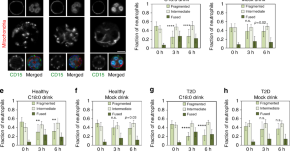
Dietary stearic acid regulates mitochondria in vivo in humans
Dietary fatty acids have different effects on human health. Here, the authors show that ingestion of the fatty acid C18:0, but not of C16:0, rapidly leads to fusion of mitochondria and fatty acid oxidation in humans, possibly explaining the health benefits of C18:0.
- Deniz Senyilmaz-Tiebe
- Daniel H. Pfaff
- Aurelio A. Teleman
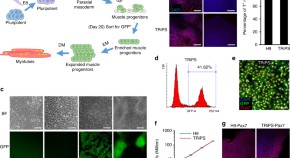
Engineering human pluripotent stem cells into a functional skeletal muscle tissue
The generation of functional skeletal muscle tissue from human pluripotent stem cells has not been reported. Here, the authors describe engineering of contractile skeletal muscle bundles in culture, which become vascularized and maintain functionality when transplanted into mice.
- Lingjun Rao
- Nenad Bursac
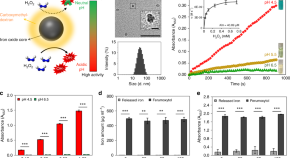
Topical ferumoxytol nanoparticles disrupt biofilms and prevent tooth decay in vivo via intrinsic catalytic activity
Ferumoxytol is a nanoparticle formulation approved for systemic use to treat iron deficiency. Liu et al. show that topical use of ferumoxytol, in combination with low concentrations of H 2 O 2 , disrupts intractable oral biofilms and prevents tooth decay in vitro and in an animal model.
- Pratap C. Naha
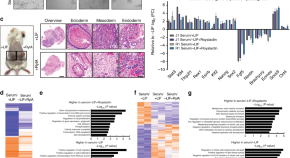
Honey bee Royalactin unlocks conserved pluripotency pathway in mammals
Royal jelly is the queen-maker for the honey bee that also has effects on longevity, fertility, and regeneration in mammals. Here the authors provide evidence that its major protein component Royalactin, and the mammalian structural analog Regina, maintain pluripotency in mouse ESCs by activating a ground-state pluripotency-like gene network.
- Derrick C. Wan
- Stefanie L. Morgan
- Kevin C. Wang
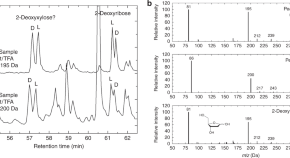
Deoxyribose and deoxysugar derivatives from photoprocessed astrophysical ice analogues and comparison to meteorites
Sugars are known to form from the UV photoprocessing of ices under astrophysical conditions. Here, the authors report the detection of deoxyribose, the sugar of DNA, and other deoxysugars from the UV photoprocessing of H 2 O:CH 3 OH ice mixtures, which are compared with materials from carbonaceous meteorites.
- Michel Nuevo
- George Cooper
- Scott A. Sandford
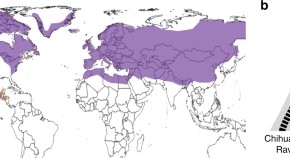
Genomic evidence of speciation reversal in ravens
Speciation reversal is known mainly from recently diverged lineages that have come into secondary contact following anthropogenic disturbance. Here, Kearns et al. use genomic and phylogenomic analyses to show that the Common Raven ( Corvus corax ) was formed by the ancient fusion of two non-sister lineages of ravens.
- Anna M. Kearns
- Marco Restani
- Kevin E. Omland
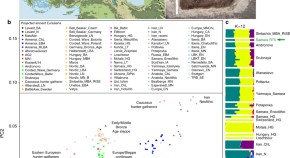
Analysis of 3800-year-old Yersinia pestis genomes suggests Bronze Age origin for bubonic plague
Yersinia pestis has caused infections (plague) in humans since the Early Bronze Age (5000 years ago). Here, Spyrou et al. reconstruct Y. pestis genomes from Late Bronze Age individuals, and find genomic evidence compatible with flea-mediated transmission causing bubonic plague.
- Maria A. Spyrou
- Rezeda I. Tukhbatova
- Johannes Krause
Quick links
- Explore articles by subject
- Guide to authors
- Editorial policies
Academia.edu no longer supports Internet Explorer.
To browse Academia.edu and the wider internet faster and more securely, please take a few seconds to upgrade your browser .
Enter the email address you signed up with and we'll email you a reset link.
- We're Hiring!
- Help Center

Compendium of "RESEARCH INSIGHTS OF LIFE SCIENCE STUDENTS"

2021, JPS scientific Publications, India
A Compendium of Research insights for life science students in various areas like Microbiology, Biotechnology, Biochemistry, Pathology etc.
Related Papers
krishna chaitanya
Dr. P. Saranraj
Fungi are an important component of soil microbiota typically having higher biomass than bacteria depending on soil depth and nutrient conditions. Generally, growth media for fungi contain carbon and nitrogen sources, and most fungi require several specific elements for growth and reproduction. Cultural medium is defined as any material in which microorganism find nourishment for growth and development. Fungi, like any other living organism, require nutrients for their life processes. This is obvious from the fact that they feed on varieties of food substances. Investigation into the composition of culture media has established that the important ingredients such as nitrogen, carbon, vitamins and growth factors, mainly essential mineral salts are required for fungal growth. The feasibility of developing alternative media for cultivation of fungi apart from the conventional ones like Sabouraud's Dextrose Agar and Potato Dextrose Agar has been studied by different researchers. The need to develop alternative media has become imperative as the conventional media are either not readily available or expensive in most developing countries. The present review was focused on the utilization of fruit peels for the growth of industrially important fungi. In this present review, we discussed about the Generation and composition of Agroindustrial wastes, Fruit peels, Fruit peel wastes in fungal growth and Utilization of fruit peel wastes for the cultivation of industrially important fungi.
A large portion of the world population, especially in developing countries depends upon the traditional system of medicine for a variety of diseases. Several hundred genera of plants are used as vital sources for potent and powerful drugs. In herbal medicine, crude plant extracts in the form of herbal extracts are used by the population for the treatment of diseases, including infectious diseases. Although, their efficacy and mechanism of action have not been tested scientifically in most cases, these simple medicinal preparations often mediate beneficial responses due to their active chemical constituents. Essential oils are volatile, natural, complex compounds that are produced by plants as secondary metabolites for protection against bacteria, viruses, fungi and pests. They also have an important role in dispersion of pollens and seeds by attracting some insects. In Middle Ages essential oils were used for preservation of foods and as flavoring, antimicrobial, analgesic, sedative, anti-inflammatory, spasmolytic and locally anesthetic remedies. But, characterizing these properties in laboratory dated back to the early 1900s. At present, about 3000 essential oils are known and 300 of them are used commercially in different industries such as pharmaceutical, agronomic, food, sanitary, cosmetic and perfume. Today, antioxidant, antitumor and antiviral, antifungal and antibacterial activity of essential oils and their constituents were widely studied. The present review was focused on the antibacterial activity of various essential oils. In this present review, we discussed about the Essential oils, Historical use of Essential oils, Antimicrobial components present in Essential oils, Mechanism of action of Essential oils, Antibacterial activity of Essential oils, Factors affecting antibacterial activity of Essential oils, Synergic effect of Essential oils and Limitations of Essential oils.
AkiNik Publications Publication
Thiruvengadam S
Yusuf Sarkingobir
A s s o c i a t i o n o f G l o b a l A c a d e m i c i a n a n d R e s e a r c h e r s (A G A R) P u b l i c a t i o n s , T a m i l N a d u , I n d i a .
Damayanti Bakra
Dr. Syed Wali Peeran
Dr D Chattopadhyay
Aseesh Pandey
Subhash J Bhore
World Environment Day (WED) is a biggest global annual event celebrated each year on June 5 to promote the awareness about the importance of preserving the environment. This book was published to commemorate the world environment day-2017 (WED-2017). The main purpose of this book is to highlight – how biotechnology can contribute for the sustainable development and in achieving sustainable development goals (SDGs) adapted by the international community to improve the health of people and planet? This book contains 38 full-length articles contributed by various researchers, scientists and academicians. to make a change in the world. In essence, a prudent use of biotechnology in the biodiversity conservation, environmental protection, production of more and better quality of food, fiber, fuel and drugs will contribute in achiving SDGs and to promote peace in the world. This book will serve as a reference to various researchers, scientists, academicians and students involved in biodiversity conservation, environmental protection and various fields of biology and biotechnology. P.S.: You may download individual chapters from https://lnkd.in/gyHqFUW Editors: Subhash Bhore, K. Marimuthu, and M. Ravichandran
RELATED PAPERS
Dr. Azharuddin Daphedar
OCEAN PUBLISHING HOUSE
Kaustubh Singh
vu thecuong
Indo-Asian Journal of Multidisciplinary Research IAJMR
Fungal Diversity
Anupama Daranagama
adelokun shakirat
Opaleke S Sketcher
Ana Maria Parave Sandoval
Norma Moraga
Benedict Zunchi Okoro
Springer Nature
Karen Rodríguez
Life Science Archives LSA , Sachin Rajaseker
Contributions in Book Chapter
Science and Education Development Institute (SEDInst)
Bro Buoyancy
Emerging Trends in Agricultural, Environmental and Rural Developmental Challenges and Solution : An Overview
Dr AMBREESH S I N G H YADAV , Surendra Singh
Life Science Archives LSA
Prashith Kekuda
Gary Harman
IFTIKHAR AHMED
IOSR Journals
Navodita George Maurice
AGROBIOS (International)
Fabian Castillo
INNOVATIONS IN TRADITIONAL FOODS
Turkish Journal of Botany
ANGANA BORAH
RELATED TOPICS
- We're Hiring!
- Help Center
- Find new research papers in:
- Health Sciences
- Earth Sciences
- Cognitive Science
- Mathematics
- Computer Science
- Academia ©2024
- USC Libraries
- Research Guides
- *Biological and Life Sciences
Quantitative Biology
*biological and life sciences: quantitative biology.
- Human Biology
- Computational Biology and Bioinformatics
- Biotechnology
- Molecular Genetics and Biochemistry
- Neuroscience
- Human Development and Aging
- Health Promotion and Disease Prevention
- Human Movement Sciences
- Natural Science
- Marine Biology
- Environmental Science
These databases will help you with specific research in quantative biology:
- arXiv Started in August 1991, arXiv.org (formerly xxx.lanl.gov) is a highly-automated electronic archive and distribution server for research articles in the areas of physics, mathematics, computer science, nonlinear sciences, quantitative biology and statistics. arXiv is maintained and operated by the Cornell University Library.
- Cold Spring Harbor Laboratory Press This resource includes access to all six of their journals; their Protocols; and the Cold Spring Harbor Symposia on Quantitative Biology. This is especially strong for molecular biology topics.
- Colloquium Digital Library of Life Sciences The Colloquium Digital Library is an original collection of PDF e-books for researchers, instructors, and advanced-level students in the biomedical life sciences. Colloquium Lectures are organized by subject area, or Series including Biotechnology; Building Blocks of the Cell: Cell Structure & Function; Cell Biology of Medicine; The Developing Brain; Developmental Biology; The Genetic Basis of Human Disease; Genomic and Molecular Medicine; Integrated Systems Physiology: From Molecule to Function to Disease; Neurobiology of Alzheimer's Disease; Neuroglia in Biology and Medicine: From Physiology to Disease; Neuropeptides; Protein Activation and Cancer; Stem Cell Biology; and Quantitative Cell Biology.
- Scopus Scopus is an expertly curated database that focuses on life sciences, physical sciences, and health sciences research. Find the latest research in the field.
Here are recent ebooks that can get you started with quantative biology:
- Quantitative Biology: Dynamics of Living Systems by Akatsuki Kimura ; Jason Edward Shoemaker ; Rinshi S. Kasai ; Ziya Kalay ; Hiroaki Takagi ; Douglas B. Murray ; Chun - Biu Li ; Akira Funahashi ; Tetsuya J. Kobayashi ; Viji M. Draviam ; Noriko Hiroi ; Naoki A. Irie ISBN: 9782889452132 Publication Date: 2017 With the emergence of Systems Biology, there is a greater realization that the whole behavior of a living system may not be simply described as the sum of its elements. To represent a living system using mathematical principles, practical quantities with units are required. Quantities are not only the bridge between mathematical description and biological observations; they often stand as essential elements similar to genome information in genetics. This important realization has greatly rejuvenated research in the area of Quantitative Biology. Because of the increased need for precise quantification, a new era of technological development has opened. For example, spatio-temporal high-resolution imaging enables us to track single molecule behavior in vivo. Clever artificial control of experimental conditions and molecular structures has expanded the variety of quantities that can be directly measured. In addition, improved computational power and novel algorithms for analyzing theoretical models have made it possible to investigate complex biological phenomena. This research topic is organized on two aspects of technological advances which are the backbone of Quantitative Biology: (i) visualization of biomolecules, their dynamics and function, and (ii) generic technologies of model optimization and numeric integration. We have also included articles highlighting the need for new quantitative approaches to solve some of the long-standing cell biology questions.
Here are some of the academic journals that USC Libraries subscribes to that are related to quantative biology:
- Cold Spring Harbor Symposia on Quantitative Biology Since 1933, major discoveries in biology--such as the structure of DNA, the genetic code, the polymerase chain reaction (PCR), and RNA interference (RNAi)--have been presented and debated at the Symposium held every summer at Cold Spring Harbor Laboratory in New York. Each Symposium focuses on a different and timely area of biological research and is attended by the leading figures in the field. The speakers are handpicked luminaries and rising stars who also publish a detailed discussion of the work they present in the annual Cold Spring Harbor Symposia on Quantitative Biology volume.
- << Previous: Human Biology
- Next: Computational Biology and Bioinformatics >>
- Last Updated: May 7, 2024 10:11 AM
- URL: https://libguides.usc.edu/biology
- Share full article
Advertisement
Supported by
Environmental Changes Are Fueling Human, Animal and Plant Diseases, Study Finds
Biodiversity loss, global warming, pollution and the spread of invasive species are making infectious diseases more dangerous to organisms around the world.

By Emily Anthes
Several large-scale, human-driven changes to the planet — including climate change, the loss of biodiversity and the spread of invasive species — are making infectious diseases more dangerous to people, animals and plants, according to a new study.
Scientists have documented these effects before in more targeted studies that have focused on specific diseases and ecosystems. For instance, they have found that a warming climate may be helping malaria expand in Africa and that a decline in wildlife diversity may be boosting Lyme disease cases in North America.
But the new research, a meta-analysis of nearly 1,000 previous studies, suggests that these patterns are relatively consistent around the globe and across the tree of life.
“It’s a big step forward in the science,” said Colin Carlson, a biologist at Georgetown University, who was not an author of the new analysis. “This paper is one of the strongest pieces of evidence that I think has been published that shows how important it is health systems start getting ready to exist in a world with climate change, with biodiversity loss.”
In what is likely to come as a more surprising finding, the researchers also found that urbanization decreased the risk of infectious disease.
The new analysis, which was published in Nature on Wednesday, focused on five “global change drivers” that are altering ecosystems across the planet: biodiversity change, climate change, chemical pollution, the introduction of nonnative species and habitat loss or change.
The researchers compiled data from scientific papers that examined how at least one of these factors affected various infectious-disease outcomes, such as severity or prevalence. The final data set included nearly 3,000 observations on disease risks for humans, animals and plants on every continent except for Antarctica.
The researchers found that, across the board, four of the five trends they studied — biodiversity change, the introduction of new species, climate change and chemical pollution — tended to increase disease risk.
“It means that we’re likely picking up general biological patterns,” said Jason Rohr, an infectious disease ecologist at the University of Notre Dame and senior author of the study. “It suggests that there are similar sorts of mechanisms and processes that are likely occurring in plants, animals and humans.”
The loss of biodiversity played an especially large role in driving up disease risk, the researchers found. Many scientists have posited that biodiversity can protect against disease through a phenomenon known as the dilution effect.
The theory holds that parasites and pathogens, which rely on having abundant hosts in order to survive, will evolve to favor species that are common, rather than those that are rare, Dr. Rohr said. And as biodiversity declines, rare species tend to disappear first. “That means that the species that remain are the competent ones, the ones that are really good at transmitting disease,” he said.
Lyme disease is one oft-cited example. White-footed mice, which are the primary reservoir for the disease, have become more dominant on the landscape, as other rarer mammals have disappeared, Dr. Rohr said. That shift may partly explain why Lyme disease rates have risen in the United States. (The extent to which the dilution effect contributes to Lyme disease risk has been the subject of debate, and other factors, including climate change, are likely to be at play as well.)
Other environmental changes could amplify disease risks in a wide variety of ways. For instance, introduced species can bring new pathogens with them, and chemical pollution can stress organisms’ immune systems. Climate change can alter animal movements and habitats, bringing new species into contact and allowing them to swap pathogens .
Notably, the fifth global environmental change that the researchers studied — habitat loss or change — appeared to reduce disease risk. At first glance, the findings might appear to be at odds with previous studies, which have shown that deforestation can increase the risk of diseases ranging from malaria to Ebola. But the overall trend toward reduced risk was driven by one specific type of habitat change: increasing urbanization.
The reason may be that urban areas often have better sanitation and public health infrastructure than rural ones — or simply because there are fewer plants and animals to serve as disease hosts in urban areas. The lack of plant and animal life is “not a good thing,” Dr. Carlson said. “And it also doesn’t mean that the animals that are in the cities are healthier.”
And the new study does not negate the idea that forest loss can fuel disease; instead, deforestation increases risk in some circumstances and reduces it in others, Dr. Rohr said.
Indeed, although this kind of meta-analysis is valuable for revealing broad patterns, it can obscure some of the nuances and exceptions that are important for managing specific diseases and ecosystems, Dr. Carlson noted.
Moreover, most of the studies included in the analysis examined just a single global change drive. But, in the real world, organisms are contending with many of these stressors simultaneously. “The next step is to better understand the connections among them,” Dr. Rohr said.
Emily Anthes is a science reporter, writing primarily about animal health and science. She also covered the coronavirus pandemic. More about Emily Anthes
Explore the Animal Kingdom
A selection of quirky, intriguing and surprising discoveries about animal life..
Indigenous rangers in Australia’s Western Desert got a rare close-up with the northern marsupial mole , which is tiny, light-colored and blind, and almost never comes to the surface.
For the first time, scientists observed an orangutan, a primate, in the wild treating a wound with a plant that has medicinal properties.
A new study resets the timing for the emergence of bioluminescence back to millions of years earlier than previously thought.
Scientists are making computer models to better understand how cicadas emerge collectively after more than a decade underground .
New research questions the long-held theory that reintroduction of Yellowstone’s wolves caused a trophic cascade , spawning renewal of vegetation and spurring biodiversity.
To protect Australia’s iconic animals, scientists are experimenting with vaccine implants , probiotics, tree-planting drones and solar-powered tracking tags.
Appointments at Mayo Clinic
Meditation: a simple, fast way to reduce stress.
Meditation can wipe away the day's stress, bringing with it inner peace. See how you can easily learn to practice meditation whenever you need it most.
If stress has you anxious, tense and worried, you might try meditation. Spending even a few minutes in meditation can help restore your calm and inner peace.
Anyone can practice meditation. It's simple and doesn't cost much. And you don't need any special equipment.
You can practice meditation wherever you are. You can meditate when you're out for a walk, riding the bus, waiting at the doctor's office or even in the middle of a business meeting.
Understanding meditation
Meditation has been around for thousands of years. Early meditation was meant to help deepen understanding of the sacred and mystical forces of life. These days, meditation is most often used to relax and lower stress.
Meditation is a type of mind-body complementary medicine. Meditation can help you relax deeply and calm your mind.
During meditation, you focus on one thing. You get rid of the stream of thoughts that may be crowding your mind and causing stress. This process can lead to better physical and emotional well-being.
Benefits of meditation
Meditation can give you a sense of calm, peace and balance that can benefit your emotional well-being and your overall health. You also can use it to relax and cope with stress by focusing on something that calms you. Meditation can help you learn to stay centered and keep inner peace.
These benefits don't end when your meditation session ends. Meditation can help take you more calmly through your day. And meditation may help you manage symptoms of some medical conditions.
Meditation and emotional and physical well-being
When you meditate, you may clear away the information overload that builds up every day and contributes to your stress.
The emotional and physical benefits of meditation can include:
- Giving you a new way to look at things that cause stress.
- Building skills to manage your stress.
- Making you more self-aware.
- Focusing on the present.
- Reducing negative feelings.
- Helping you be more creative.
- Helping you be more patient.
- Lowering resting heart rate.
- Lowering resting blood pressure.
- Helping you sleep better.
Meditation and illness
Meditation also might help if you have a medical condition. This is most often true if you have a condition that stress makes worse.
A lot of research shows that meditation is good for health. But some experts believe there's not enough research to prove that meditation helps.
With that in mind, some research suggests that meditation may help people manage symptoms of conditions such as:
- Chronic pain.
- Depression.
- Heart disease.
- High blood pressure.
- Irritable bowel syndrome.
- Sleep problems.
- Tension headaches.
Be sure to talk to your healthcare professional about the pros and cons of using meditation if you have any of these or other health conditions. Sometimes, meditation might worsen symptoms linked to some mental health conditions.
Meditation doesn't replace medical treatment. But it may help to add it to other treatments.
Types of meditation
Meditation is an umbrella term for the many ways to get to a relaxed state. There are many types of meditation and ways to relax that use parts of meditation. All share the same goal of gaining inner peace.
Ways to meditate can include:
Guided meditation. This is sometimes called guided imagery or visualization. With this method of meditation, you form mental images of places or things that help you relax.
You try to use as many senses as you can. These include things you can smell, see, hear and feel. You may be led through this process by a guide or teacher.
- Mantra meditation. In this type of meditation, you repeat a calming word, thought or phrase to keep out unwanted thoughts.
Mindfulness meditation. This type of meditation is based on being mindful. This means being more aware of the present.
In mindfulness meditation, you focus on one thing, such as the flow of your breath. You can notice your thoughts and feelings. But let them pass without judging them.
- Qigong. This practice most often combines meditation, relaxation, movement and breathing exercises to restore and maintain balance. Qigong (CHEE-gung) is part of Chinese medicine.
- Tai chi. This is a form of gentle Chinese martial arts training. In tai chi (TIE-CHEE), you do a series of postures or movements in a slow, graceful way. And you do deep breathing with the movements.
- Yoga. You do a series of postures with controlled breathing. This helps give you a more flexible body and a calm mind. To do the poses, you need to balance and focus. That helps you to focus less on your busy day and more on the moment.
Parts of meditation
Each type of meditation may include certain features to help you meditate. These may vary depending on whose guidance you follow or who's teaching a class. Some of the most common features in meditation include:
Focused attention. Focusing your attention is one of the most important elements of meditation.
Focusing your attention is what helps free your mind from the many things that cause stress and worry. You can focus your attention on things such as a certain object, an image, a mantra or even your breathing.
- Relaxed breathing. This technique involves deep, even-paced breathing using the muscle between your chest and your belly, called the diaphragm muscle, to expand your lungs. The purpose is to slow your breathing, take in more oxygen, and reduce the use of shoulder, neck and upper chest muscles while breathing so that you breathe better.
A quiet setting. If you're a beginner, meditation may be easier if you're in a quiet spot. Aim to have fewer things that can distract you, including no television, computers or cellphones.
As you get more skilled at meditation, you may be able to do it anywhere. This includes high-stress places, such as a traffic jam, a stressful work meeting or a long line at the grocery store. This is when you can get the most out of meditation.
- A comfortable position. You can practice meditation whether you're sitting, lying down, walking, or in other positions or activities. Just try to be comfortable so that you can get the most out of your meditation. Aim to keep good posture during meditation.
- Open attitude. Let thoughts pass through your mind without judging them.
Everyday ways to practice meditation
Don't let the thought of meditating the "right" way add to your stress. If you choose to, you can attend special meditation centers or group classes led by trained instructors. But you also can practice meditation easily on your own. There are apps to use too.
And you can make meditation as formal or informal as you like. Some people build meditation into their daily routine. For example, they may start and end each day with an hour of meditation. But all you really need is a few minutes a day for meditation.
Here are some ways you can practice meditation on your own, whenever you choose:
Breathe deeply. This is good for beginners because breathing is a natural function.
Focus all your attention on your breathing. Feel your breath and listen to it as you inhale and exhale through your nostrils. Breathe deeply and slowly. When your mind wanders, gently return your focus to your breathing.
Scan your body. When using this technique, focus attention on each part of your body. Become aware of how your body feels. That might be pain, tension, warmth or relaxation.
Mix body scanning with breathing exercises and think about breathing heat or relaxation into and out of the parts of your body.
- Repeat a mantra. You can create your own mantra. It can be religious or not. Examples of religious mantras include the Jesus Prayer in the Christian tradition, the holy name of God in Judaism, or the om mantra of Hinduism, Buddhism and other Eastern religions.
Walk and meditate. Meditating while walking is a good and healthy way to relax. You can use this technique anywhere you're walking, such as in a forest, on a city sidewalk or at the mall.
When you use this method, slow your walking pace so that you can focus on each movement of your legs or feet. Don't focus on where you're going. Focus on your legs and feet. Repeat action words in your mind such as "lifting," "moving" and "placing" as you lift each foot, move your leg forward and place your foot on the ground. Focus on the sights, sounds and smells around you.
Pray. Prayer is the best known and most widely used type of meditation. Spoken and written prayers are found in most faith traditions.
You can pray using your own words or read prayers written by others. Check the self-help section of your local bookstore for examples. Talk with your rabbi, priest, pastor or other spiritual leader about possible resources.
Read and reflect. Many people report that they benefit from reading poems or sacred texts and taking a few moments to think about their meaning.
You also can listen to sacred music, spoken words, or any music that relaxes or inspires you. You may want to write your thoughts in a journal or discuss them with a friend or spiritual leader.
- Focus your love and kindness. In this type of meditation, you think of others with feelings of love, compassion and kindness. This can help increase how connected you feel to others.
Building your meditation skills
Don't judge how you meditate. That can increase your stress. Meditation takes practice.
It's common for your mind to wander during meditation, no matter how long you've been practicing meditation. If you're meditating to calm your mind and your mind wanders, slowly return to what you're focusing on.
Try out ways to meditate to find out what types of meditation work best for you and what you enjoy doing. Adapt meditation to your needs as you go. Remember, there's no right way or wrong way to meditate. What matters is that meditation helps you reduce your stress and feel better overall.
Related information
- Relaxation techniques: Try these steps to lower stress - Related information Relaxation techniques: Try these steps to lower stress
- Stress relievers: Tips to tame stress - Related information Stress relievers: Tips to tame stress
- Video: Need to relax? Take a break for meditation - Related information Video: Need to relax? Take a break for meditation
There is a problem with information submitted for this request. Review/update the information highlighted below and resubmit the form.
From Mayo Clinic to your inbox
Sign up for free and stay up to date on research advancements, health tips, current health topics, and expertise on managing health. Click here for an email preview.
Error Email field is required
Error Include a valid email address
To provide you with the most relevant and helpful information, and understand which information is beneficial, we may combine your email and website usage information with other information we have about you. If you are a Mayo Clinic patient, this could include protected health information. If we combine this information with your protected health information, we will treat all of that information as protected health information and will only use or disclose that information as set forth in our notice of privacy practices. You may opt-out of email communications at any time by clicking on the unsubscribe link in the e-mail.
Thank you for subscribing!
You'll soon start receiving the latest Mayo Clinic health information you requested in your inbox.
Sorry something went wrong with your subscription
Please, try again in a couple of minutes
- Meditation: In depth. National Center for Complementary and Integrative Health. https://nccih.nih.gov/health/meditation/overview.htm. Accessed Dec. 23, 2021.
- Mindfulness meditation: A research-proven way to reduce stress. American Psychological Association. https://www.apa.org/topics/mindfulness/meditation. Accessed Dec. 23, 2021.
- AskMayoExpert. Meditation. Mayo Clinic. 2021.
- Papadakis MA, et al., eds. Meditation. In: Current Medical Diagnosis & Treatment 2022. 61st ed. McGraw Hill; 2022. https://accessmedicine.mhmedical.com. Accessed Dec. 23, 2021.
- Hilton L, et al. Mindfulness meditation for chronic pain: Systematic review and meta-analysis. Annals of Behavioral Medicine. 2017; doi:10.1007/s12160-016-9844-2.
- Seaward BL. Meditation. In: Essentials of Managing Stress. 5th ed. Jones & Bartlett Learning; 2021.
- Seaward BL. Managing Stress: Principles and Strategies for Health and Well-Being. 9th ed. Burlington, Mass.: Jones & Bartlett Learning; 2018.
Products and Services
- A Book: Mayo Clinic Handbook for Happiness
- A very happy brain
- Alternative cancer treatments: 11 options to consider
- Brain tumor
- Brain Tumor
- What is a brain tumor? A Mayo Clinic expert explains
- Brain tumor FAQs
- Living with Brain Tumors
- Long Term Brain Cancer Survivor
- Mayo Clinic Minute: Meditation is good medicine
- Meditation 2.0: A new way to meditate
- Parkinson's disease
- Punk Guitarist Survives Brain Tumor
- Guided meditation video
Mayo Clinic does not endorse companies or products. Advertising revenue supports our not-for-profit mission.
- Opportunities
Mayo Clinic Press
Check out these best-sellers and special offers on books and newsletters from Mayo Clinic Press .
- Mayo Clinic on Incontinence - Mayo Clinic Press Mayo Clinic on Incontinence
- The Essential Diabetes Book - Mayo Clinic Press The Essential Diabetes Book
- Mayo Clinic on Hearing and Balance - Mayo Clinic Press Mayo Clinic on Hearing and Balance
- FREE Mayo Clinic Diet Assessment - Mayo Clinic Press FREE Mayo Clinic Diet Assessment
- Mayo Clinic Health Letter - FREE book - Mayo Clinic Press Mayo Clinic Health Letter - FREE book
- Meditation A simple fast way to reduce stress
Your gift holds great power – donate today!
Make your tax-deductible gift and be a part of the cutting-edge research and care that's changing medicine.
Purdue Online Writing Lab Purdue OWL® College of Liberal Arts
Welcome to the Purdue Online Writing Lab

Welcome to the Purdue OWL
This page is brought to you by the OWL at Purdue University. When printing this page, you must include the entire legal notice.
Copyright ©1995-2018 by The Writing Lab & The OWL at Purdue and Purdue University. All rights reserved. This material may not be published, reproduced, broadcast, rewritten, or redistributed without permission. Use of this site constitutes acceptance of our terms and conditions of fair use.
The Online Writing Lab at Purdue University houses writing resources and instructional material, and we provide these as a free service of the Writing Lab at Purdue. Students, members of the community, and users worldwide will find information to assist with many writing projects. Teachers and trainers may use this material for in-class and out-of-class instruction.
The Purdue On-Campus Writing Lab and Purdue Online Writing Lab assist clients in their development as writers—no matter what their skill level—with on-campus consultations, online participation, and community engagement. The Purdue Writing Lab serves the Purdue, West Lafayette, campus and coordinates with local literacy initiatives. The Purdue OWL offers global support through online reference materials and services.
A Message From the Assistant Director of Content Development
The Purdue OWL® is committed to supporting students, instructors, and writers by offering a wide range of resources that are developed and revised with them in mind. To do this, the OWL team is always exploring possibilties for a better design, allowing accessibility and user experience to guide our process. As the OWL undergoes some changes, we welcome your feedback and suggestions by email at any time.
Please don't hesitate to contact us via our contact page if you have any questions or comments.
All the best,
Social Media
Facebook twitter.

IMAGES
VIDEO
COMMENTS
Top 50 Life and Biological Sciences Articles. We are pleased to share with you the 50 most read Nature Communications articles* in life and biological sciences published in 2019. Featuring authors ...
Explore the latest full-text research PDFs, articles, conference papers, preprints and more on LIFE SCIENCES. Find methods information, sources, references or conduct a literature review on LIFE ...
251+ Life Science Research Topics [Updated] General / By Stat Analytica / 17th February 2024. Life science research is like peering into the intricate workings of the universe, but instead of stars and galaxies, it delves into the mysteries of life itself. From unraveling the secrets of our genetic code to understanding ecosystems and ...
Abstract. The present book entitled "Current Research and Innovations in Life Sciences" gathers the recent and latest trends in innovative research achieved. The book is the most wide-ranging ...
Browse 486 science publications on Biology and Life Sciences from the National Academies Press. ... prestigious journals publish the latest scientific findings on a wide range of topics. Learn More . Topics . Coronavirus Disease 2019 (COVID-19) Diversity, Equity, and Inclusion ... Read Online Download Free PDF 81 downloads. Prepublication ...
EMERGING TOPICS IN LIFE SCIENCES Interpreting and Integrating Big Data in the Life Sciences Guest Editor: Matteo Pellegrini (University of California, USA) ... Reflecting the interdisciplinary nature of life science research, Emerging Topics in Life Sciences is a journal jointly owned by the Royal Society of Biology and the Biochemical
Fig. 2 Schematic model of how emerging topics are generated in life science field. Small alphabet letters (a to o) indicate the elements of life science topics that are represented by MeSH terms in this study. Large alphabet letters (A and B) indicate the newly appeared elements of novel emerging topics.
This working paper aims to identify the main issues associated with potential misuse of life science R&D in a general way, to promote informed discussion. The issues are reviewed from a public health perspective, as any mechanism designed to manage the risk of deliberate misuse would also affect public health.
empower life science research across Sweden and across all sectors of life science. • We are dedicated to advancing and disseminating knowledge in technology- and data-driven topics in life science. • We strive for excellence, reproducibility and integrity of our research as well as open accessibility and
Great Examples of Life Science Research Topics. Impact of climate change on a specific ecosystem. Investigating the genetics of a hereditary disease. Effects of different diets on human metabolism. Role of microorganisms in environmental cleanup. Study of biodiversity in a local habitat. Analyzing the effectiveness of natural remedies in ...
Life Sciences is an international journal publishing articles that emphasize the molecular, cellular, and functional basis of therapy. The journal emphasizes the understanding of mechanism that is relevant to all aspects of human disease and translation to patients. All articles are rigorously …. View full aims & scope.
Life Science Network features a scientific publication module you can use to share your research in life sciences and related disciplines. The module integrates post-publication review features. Publications can be uploaded or imported from PubMed. For latest content published in some of the most popular scientific journals, check our Journal ...
Past, present, and future of chemically induced hepatocarcinogenesis rodent models: Perspectives concerning classic and new cancer hallmarks. Guilherme Ribeiro Romualdo, Renato Heidor, Gabriel Prata Bacil, Fernando Salvador Moreno, Luís Fernando Barbisan. Article 121994. View PDF.
Research Topic For Life Science 2023. Sr. No. Research Topic. Check Thesis. 1. Purification and characterization of adult brugia malayiantigen identification and immunprophylactic evaluation of protective molecules. Download. 2. Incidence of hiv positivity in cases of malignancy.
Explore the 50 most read life and biological sciences articles published in Nature Communications in 2018. ... these papers highlight valuable research from an international community.
The concept and content progression in the Life Sciences Specific aims of life sciences There are three broad subject-speci c aims of Life Sciences which relate to the purposes of learning science. These are: Speci c Aim 1, which relates to knowing the subject content ( theory ); Speci c Aim 2, which relates to doing science or practical work and
The ideas are building upon students' science understanding of disciplinary core ideas, science and engineering practices, and crosscutting concepts from earlier grades. There are five life science topics in high school: 1) Structure and Function, 2) Inheritance and Variation of Traits, Matter and Energy in Organisms and Ecosystems, 4 ...
Our introductory mathematics sequence for life science majors, Mathematics 115/116-Life Science Calculus 1/2, addresses two of these themes. First, mathematical, computational, and statistical methods are of ever-growing importance in the life sciences. We introduce the basic quantitative tools required in modern life science research, adhering ...
Compendium of "RESEARCH INSIGHTS OF LIFE SCIENCE STUDENTS". A Compendium of Research insights for life science students in various areas like Microbiology, Biotechnology, Biochemistry, Pathology etc. Fungi are an important component of soil microbiota typically having higher biomass than bacteria depending on soil depth and nutrient conditions.
The Colloquium Digital Library is an original collection of PDF e-books for researchers, instructors, and advanced-level students in the biomedical life sciences. ... Scopus is an expertly curated database that focuses on life sciences, physical sciences, and health sciences research. ... This research topic is organized on two aspects of ...
Life Science is the science of living things, like animals or plants, or even people. Life scientists study how living things are made, how they grow, how they behave, and how they act with other living things or their environment. Dog Monkey Virus Corn Fly Cow Gecko Lobster Rabbit Snake Begonia Woodchuck Armadillo Frog.
New research questions the long-held theory that reintroduction of Yellowstone's wolves caused a trophic cascade, spawning renewal of vegetation and spurring biodiversity.
Meditation has been around for thousands of years. Early meditation was meant to help deepen understanding of the sacred and mystical forces of life. These days, meditation is most often used to relax and lower stress. Meditation is a type of mind-body complementary medicine. Meditation can help you relax deeply and calm your mind.
The Online Writing Lab at Purdue University houses writing resources and instructional material, and we provide these as a free service of the Writing Lab at Purdue.
AP Seminar and AP Research students to submit performance tasks as final and their presentations to be scored by their AP Seminar or AP Research teachers. AP Computer Science Principles students to submit their Create performance task as final. Late Testing . Occasionally, circumstances make it necessary for students to test late.